Analysis of Manufacturing Systems: KPIs, Layouts, and Improvement
VerifiedAdded on 2023/04/21
|22
|5934
|142
Report
AI Summary
This report provides a comprehensive analysis of manufacturing systems, focusing on key performance indicators (KPIs) and their role in addressing competitiveness issues. It explores approaches for establishing performance measures at the shop floor level, including heuristic and linear programming models, and explains how these measures contribute to achieving corporate objectives. The report also details product flow analysis (PFA) and value stream mapping (VSM), illustrating their uses in manufacturing companies to optimize processes. Different types of plant layouts are described, along with their benefits related to production varieties, volume, and economies of scale. Furthermore, the document includes a critical review of tools and techniques for process improvement within lean manufacturing systems, and defines various acronyms commonly used in the field, such as CNC, CAD, BOM, and ERP. The report also contains a case study on performance assessment of a manufacturing plant.
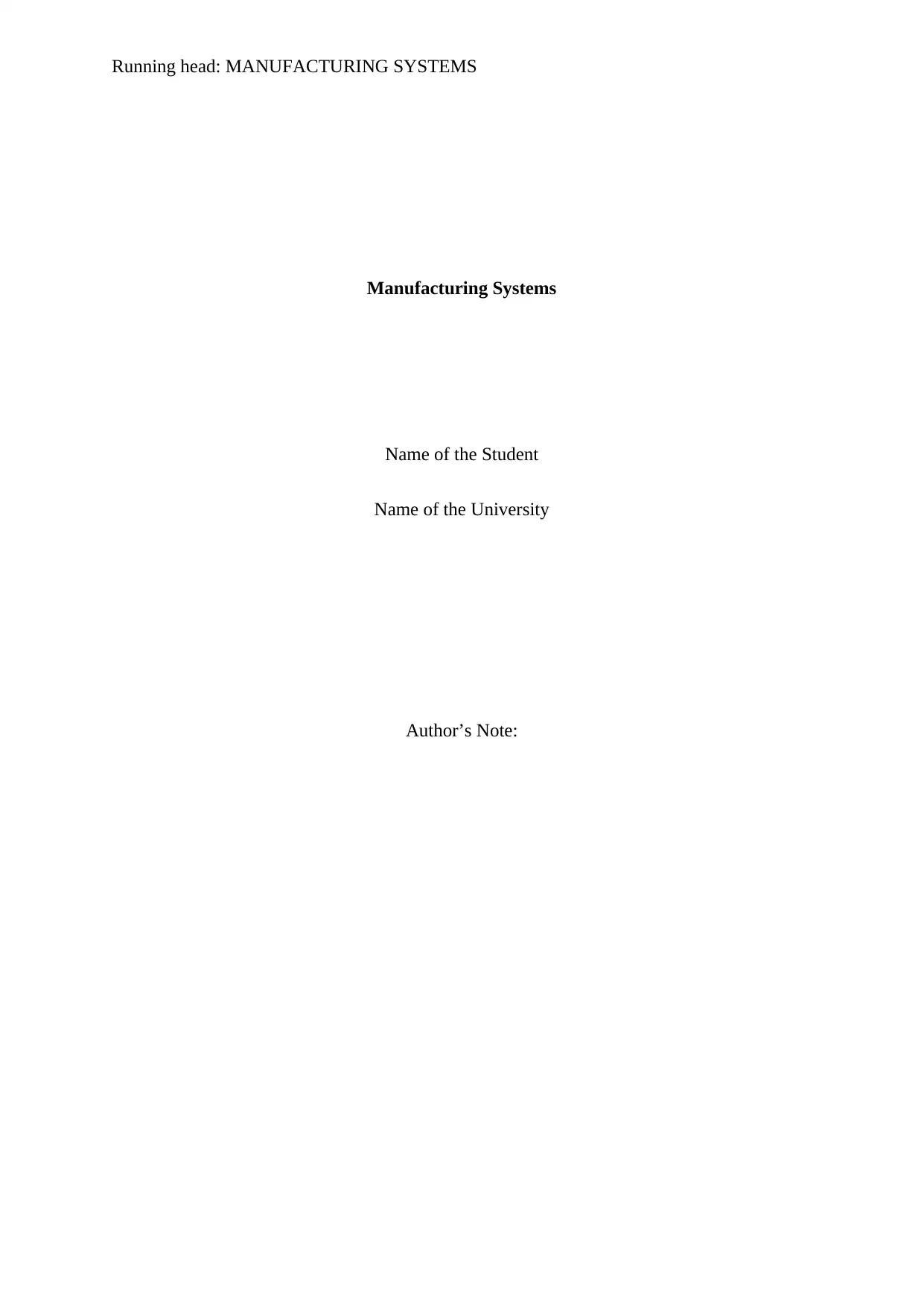
Running head: MANUFACTURING SYSTEMS
Manufacturing Systems
Name of the Student
Name of the University
Author’s Note:
Manufacturing Systems
Name of the Student
Name of the University
Author’s Note:
Paraphrase This Document
Need a fresh take? Get an instant paraphrase of this document with our AI Paraphraser
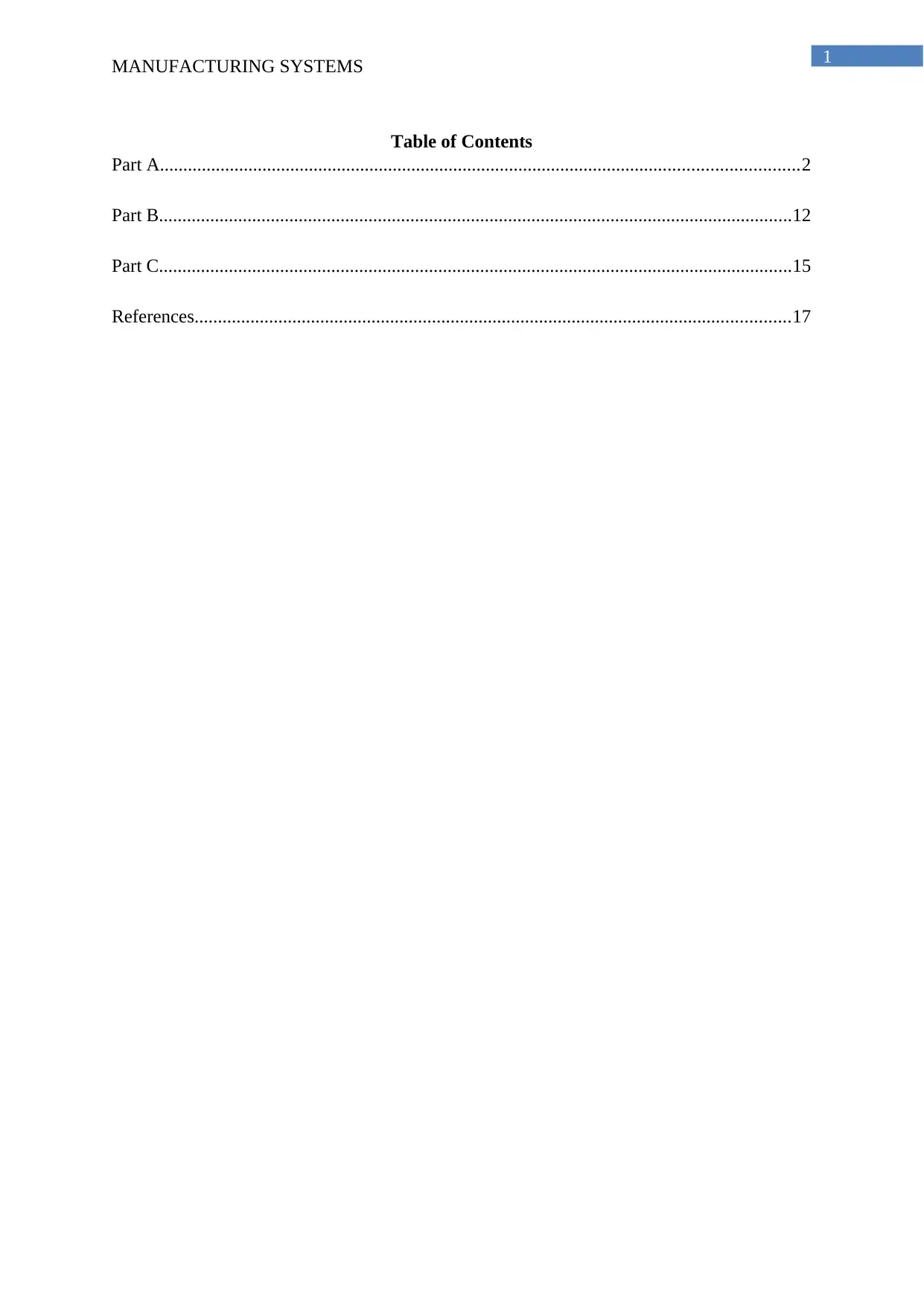
1
MANUFACTURING SYSTEMS
Table of Contents
Part A.........................................................................................................................................2
Part B........................................................................................................................................12
Part C........................................................................................................................................15
References................................................................................................................................17
MANUFACTURING SYSTEMS
Table of Contents
Part A.........................................................................................................................................2
Part B........................................................................................................................................12
Part C........................................................................................................................................15
References................................................................................................................................17
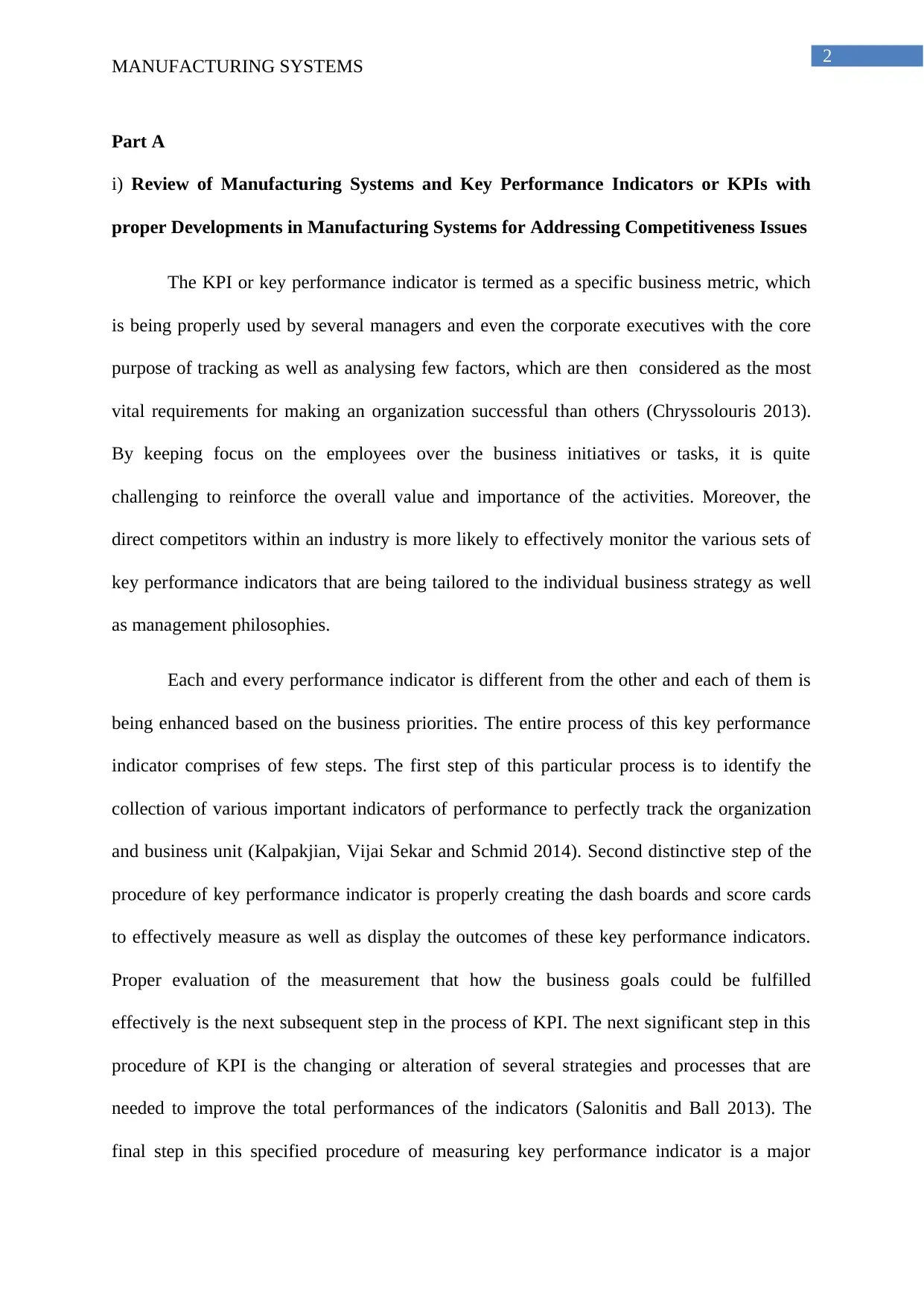
2
MANUFACTURING SYSTEMS
Part A
i) Review of Manufacturing Systems and Key Performance Indicators or KPIs with
proper Developments in Manufacturing Systems for Addressing Competitiveness Issues
The KPI or key performance indicator is termed as a specific business metric, which
is being properly used by several managers and even the corporate executives with the core
purpose of tracking as well as analysing few factors, which are then considered as the most
vital requirements for making an organization successful than others (Chryssolouris 2013).
By keeping focus on the employees over the business initiatives or tasks, it is quite
challenging to reinforce the overall value and importance of the activities. Moreover, the
direct competitors within an industry is more likely to effectively monitor the various sets of
key performance indicators that are being tailored to the individual business strategy as well
as management philosophies.
Each and every performance indicator is different from the other and each of them is
being enhanced based on the business priorities. The entire process of this key performance
indicator comprises of few steps. The first step of this particular process is to identify the
collection of various important indicators of performance to perfectly track the organization
and business unit (Kalpakjian, Vijai Sekar and Schmid 2014). Second distinctive step of the
procedure of key performance indicator is properly creating the dash boards and score cards
to effectively measure as well as display the outcomes of these key performance indicators.
Proper evaluation of the measurement that how the business goals could be fulfilled
effectively is the next subsequent step in the process of KPI. The next significant step in this
procedure of KPI is the changing or alteration of several strategies and processes that are
needed to improve the total performances of the indicators (Salonitis and Ball 2013). The
final step in this specified procedure of measuring key performance indicator is a major
MANUFACTURING SYSTEMS
Part A
i) Review of Manufacturing Systems and Key Performance Indicators or KPIs with
proper Developments in Manufacturing Systems for Addressing Competitiveness Issues
The KPI or key performance indicator is termed as a specific business metric, which
is being properly used by several managers and even the corporate executives with the core
purpose of tracking as well as analysing few factors, which are then considered as the most
vital requirements for making an organization successful than others (Chryssolouris 2013).
By keeping focus on the employees over the business initiatives or tasks, it is quite
challenging to reinforce the overall value and importance of the activities. Moreover, the
direct competitors within an industry is more likely to effectively monitor the various sets of
key performance indicators that are being tailored to the individual business strategy as well
as management philosophies.
Each and every performance indicator is different from the other and each of them is
being enhanced based on the business priorities. The entire process of this key performance
indicator comprises of few steps. The first step of this particular process is to identify the
collection of various important indicators of performance to perfectly track the organization
and business unit (Kalpakjian, Vijai Sekar and Schmid 2014). Second distinctive step of the
procedure of key performance indicator is properly creating the dash boards and score cards
to effectively measure as well as display the outcomes of these key performance indicators.
Proper evaluation of the measurement that how the business goals could be fulfilled
effectively is the next subsequent step in the process of KPI. The next significant step in this
procedure of KPI is the changing or alteration of several strategies and processes that are
needed to improve the total performances of the indicators (Salonitis and Ball 2013). The
final step in this specified procedure of measuring key performance indicator is a major
You're viewing a preview
Unlock full access by subscribing today!

3
MANUFACTURING SYSTEMS
evaluation of the factor that whether all the key performance indicators are properly aligned
with these objectives or goals of the business or not to get adjusted according to the needs.
KPIs are extremely vital and significant for checking the functions of the various
manufacturing tasks in any manufacturing organization.
In recent times, various types of major developments are taking place within a
specific manufacturing system (Colledani et al. 2014). Each and every kind of existing trend
within these manufacturing systems can be properly assessed to check the total efficiency or
effectiveness. The higher authorities have the core responsibility to play few of the important
or vital roles within a manufacturing industry so that it could lead the business to high
concentration as well as consolidation. Various kinds of the competitive pressures in a
manufacturing organization are needed to be properly addressed so that this particular
company does not confront any problem about operational efficiency (Diaz-Elsayed et al.
2013). Moreover, the most basic style of this specific development type is completely based
on restructure of technologies and systems. Relevant suggestions to eradicate such
competitive problems could eventually emerge within the recent development form.
Therefore, this organization could eventually detect the errors and faults or could even take
significant measures to properly obtain a good position in the existing market place (Haapala
et al. 2013). Certain innovations and inventions are present here as the particular company
can promptly eliminate every competitive issue within the business.
ii) Approaches for Establishing Performance Measures at the Shop Floor Level
Production and Explanation of Measures being implemented in Manufacturing
Company for Achieving Corporate Objectives
An accurate measurement and evaluation of the performances is extremely important
and significant and is also termed as one of the major need in a manufacturing organization.
MANUFACTURING SYSTEMS
evaluation of the factor that whether all the key performance indicators are properly aligned
with these objectives or goals of the business or not to get adjusted according to the needs.
KPIs are extremely vital and significant for checking the functions of the various
manufacturing tasks in any manufacturing organization.
In recent times, various types of major developments are taking place within a
specific manufacturing system (Colledani et al. 2014). Each and every kind of existing trend
within these manufacturing systems can be properly assessed to check the total efficiency or
effectiveness. The higher authorities have the core responsibility to play few of the important
or vital roles within a manufacturing industry so that it could lead the business to high
concentration as well as consolidation. Various kinds of the competitive pressures in a
manufacturing organization are needed to be properly addressed so that this particular
company does not confront any problem about operational efficiency (Diaz-Elsayed et al.
2013). Moreover, the most basic style of this specific development type is completely based
on restructure of technologies and systems. Relevant suggestions to eradicate such
competitive problems could eventually emerge within the recent development form.
Therefore, this organization could eventually detect the errors and faults or could even take
significant measures to properly obtain a good position in the existing market place (Haapala
et al. 2013). Certain innovations and inventions are present here as the particular company
can promptly eliminate every competitive issue within the business.
ii) Approaches for Establishing Performance Measures at the Shop Floor Level
Production and Explanation of Measures being implemented in Manufacturing
Company for Achieving Corporate Objectives
An accurate measurement and evaluation of the performances is extremely important
and significant and is also termed as one of the major need in a manufacturing organization.
Paraphrase This Document
Need a fresh take? Get an instant paraphrase of this document with our AI Paraphraser
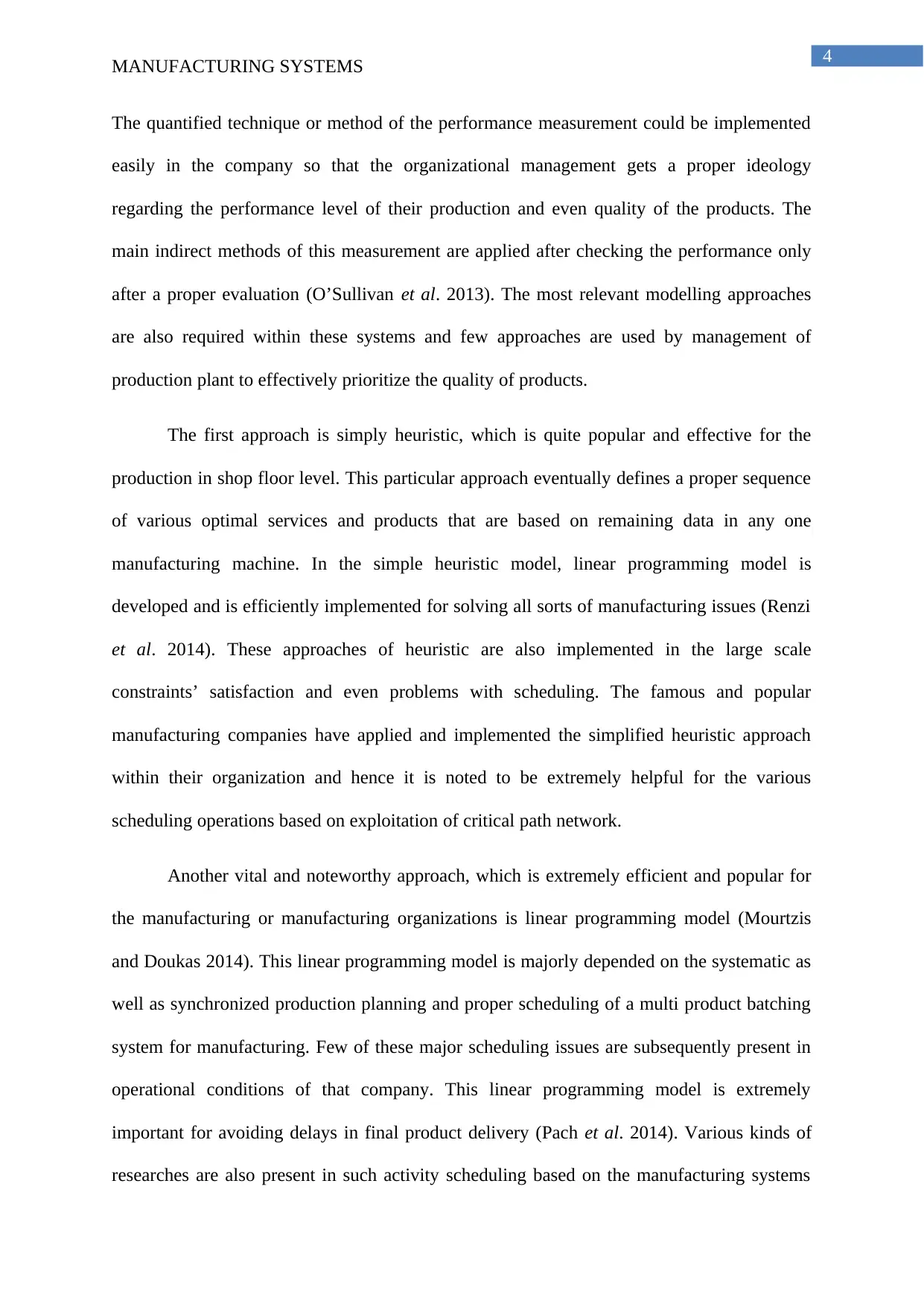
4
MANUFACTURING SYSTEMS
The quantified technique or method of the performance measurement could be implemented
easily in the company so that the organizational management gets a proper ideology
regarding the performance level of their production and even quality of the products. The
main indirect methods of this measurement are applied after checking the performance only
after a proper evaluation (O’Sullivan et al. 2013). The most relevant modelling approaches
are also required within these systems and few approaches are used by management of
production plant to effectively prioritize the quality of products.
The first approach is simply heuristic, which is quite popular and effective for the
production in shop floor level. This particular approach eventually defines a proper sequence
of various optimal services and products that are based on remaining data in any one
manufacturing machine. In the simple heuristic model, linear programming model is
developed and is efficiently implemented for solving all sorts of manufacturing issues (Renzi
et al. 2014). These approaches of heuristic are also implemented in the large scale
constraints’ satisfaction and even problems with scheduling. The famous and popular
manufacturing companies have applied and implemented the simplified heuristic approach
within their organization and hence it is noted to be extremely helpful for the various
scheduling operations based on exploitation of critical path network.
Another vital and noteworthy approach, which is extremely efficient and popular for
the manufacturing or manufacturing organizations is linear programming model (Mourtzis
and Doukas 2014). This linear programming model is majorly depended on the systematic as
well as synchronized production planning and proper scheduling of a multi product batching
system for manufacturing. Few of these major scheduling issues are subsequently present in
operational conditions of that company. This linear programming model is extremely
important for avoiding delays in final product delivery (Pach et al. 2014). Various kinds of
researches are also present in such activity scheduling based on the manufacturing systems
MANUFACTURING SYSTEMS
The quantified technique or method of the performance measurement could be implemented
easily in the company so that the organizational management gets a proper ideology
regarding the performance level of their production and even quality of the products. The
main indirect methods of this measurement are applied after checking the performance only
after a proper evaluation (O’Sullivan et al. 2013). The most relevant modelling approaches
are also required within these systems and few approaches are used by management of
production plant to effectively prioritize the quality of products.
The first approach is simply heuristic, which is quite popular and effective for the
production in shop floor level. This particular approach eventually defines a proper sequence
of various optimal services and products that are based on remaining data in any one
manufacturing machine. In the simple heuristic model, linear programming model is
developed and is efficiently implemented for solving all sorts of manufacturing issues (Renzi
et al. 2014). These approaches of heuristic are also implemented in the large scale
constraints’ satisfaction and even problems with scheduling. The famous and popular
manufacturing companies have applied and implemented the simplified heuristic approach
within their organization and hence it is noted to be extremely helpful for the various
scheduling operations based on exploitation of critical path network.
Another vital and noteworthy approach, which is extremely efficient and popular for
the manufacturing or manufacturing organizations is linear programming model (Mourtzis
and Doukas 2014). This linear programming model is majorly depended on the systematic as
well as synchronized production planning and proper scheduling of a multi product batching
system for manufacturing. Few of these major scheduling issues are subsequently present in
operational conditions of that company. This linear programming model is extremely
important for avoiding delays in final product delivery (Pach et al. 2014). Various kinds of
researches are also present in such activity scheduling based on the manufacturing systems
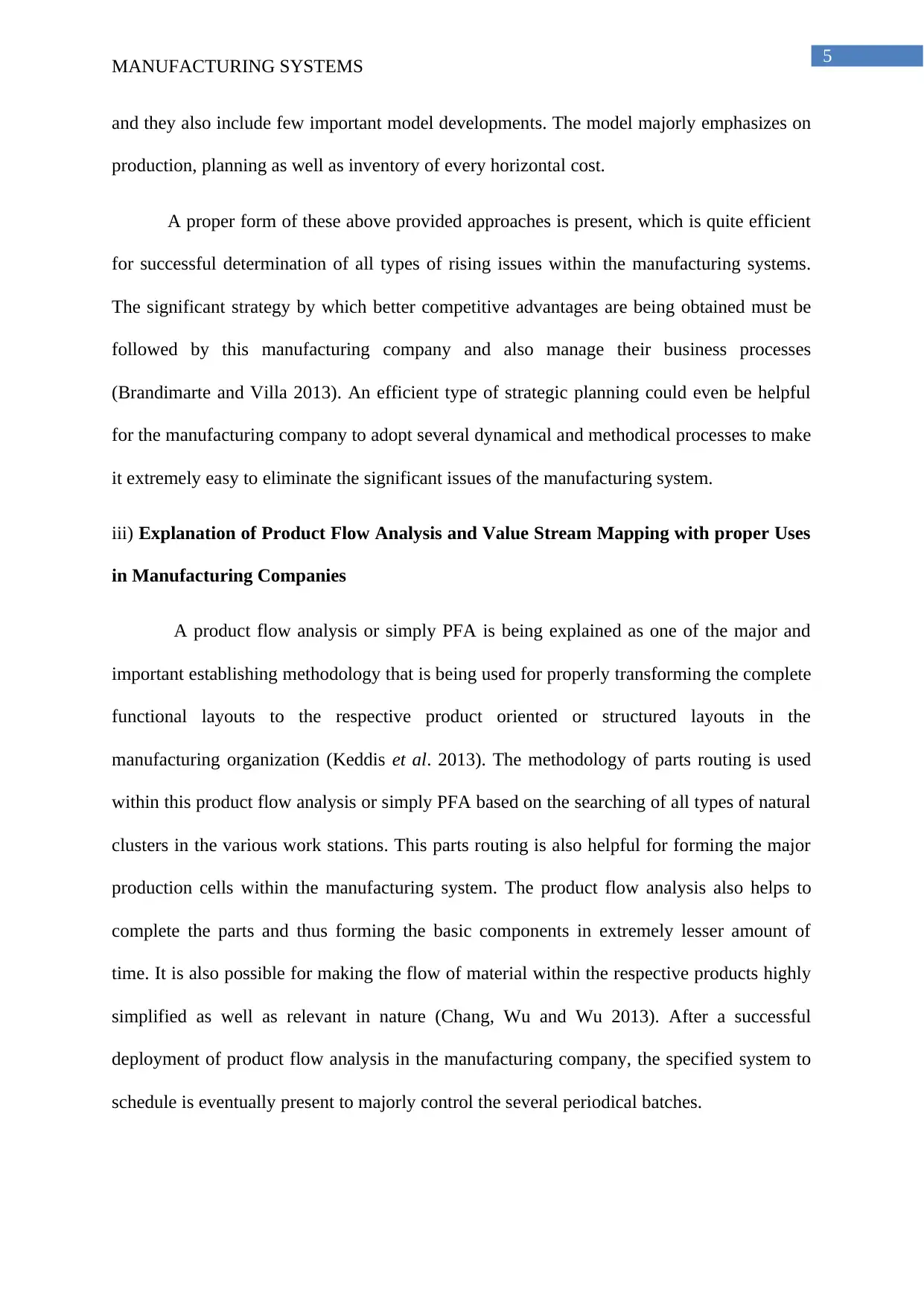
5
MANUFACTURING SYSTEMS
and they also include few important model developments. The model majorly emphasizes on
production, planning as well as inventory of every horizontal cost.
A proper form of these above provided approaches is present, which is quite efficient
for successful determination of all types of rising issues within the manufacturing systems.
The significant strategy by which better competitive advantages are being obtained must be
followed by this manufacturing company and also manage their business processes
(Brandimarte and Villa 2013). An efficient type of strategic planning could even be helpful
for the manufacturing company to adopt several dynamical and methodical processes to make
it extremely easy to eliminate the significant issues of the manufacturing system.
iii) Explanation of Product Flow Analysis and Value Stream Mapping with proper Uses
in Manufacturing Companies
A product flow analysis or simply PFA is being explained as one of the major and
important establishing methodology that is being used for properly transforming the complete
functional layouts to the respective product oriented or structured layouts in the
manufacturing organization (Keddis et al. 2013). The methodology of parts routing is used
within this product flow analysis or simply PFA based on the searching of all types of natural
clusters in the various work stations. This parts routing is also helpful for forming the major
production cells within the manufacturing system. The product flow analysis also helps to
complete the parts and thus forming the basic components in extremely lesser amount of
time. It is also possible for making the flow of material within the respective products highly
simplified as well as relevant in nature (Chang, Wu and Wu 2013). After a successful
deployment of product flow analysis in the manufacturing company, the specified system to
schedule is eventually present to majorly control the several periodical batches.
MANUFACTURING SYSTEMS
and they also include few important model developments. The model majorly emphasizes on
production, planning as well as inventory of every horizontal cost.
A proper form of these above provided approaches is present, which is quite efficient
for successful determination of all types of rising issues within the manufacturing systems.
The significant strategy by which better competitive advantages are being obtained must be
followed by this manufacturing company and also manage their business processes
(Brandimarte and Villa 2013). An efficient type of strategic planning could even be helpful
for the manufacturing company to adopt several dynamical and methodical processes to make
it extremely easy to eliminate the significant issues of the manufacturing system.
iii) Explanation of Product Flow Analysis and Value Stream Mapping with proper Uses
in Manufacturing Companies
A product flow analysis or simply PFA is being explained as one of the major and
important establishing methodology that is being used for properly transforming the complete
functional layouts to the respective product oriented or structured layouts in the
manufacturing organization (Keddis et al. 2013). The methodology of parts routing is used
within this product flow analysis or simply PFA based on the searching of all types of natural
clusters in the various work stations. This parts routing is also helpful for forming the major
production cells within the manufacturing system. The product flow analysis also helps to
complete the parts and thus forming the basic components in extremely lesser amount of
time. It is also possible for making the flow of material within the respective products highly
simplified as well as relevant in nature (Chang, Wu and Wu 2013). After a successful
deployment of product flow analysis in the manufacturing company, the specified system to
schedule is eventually present to majorly control the several periodical batches.
You're viewing a preview
Unlock full access by subscribing today!
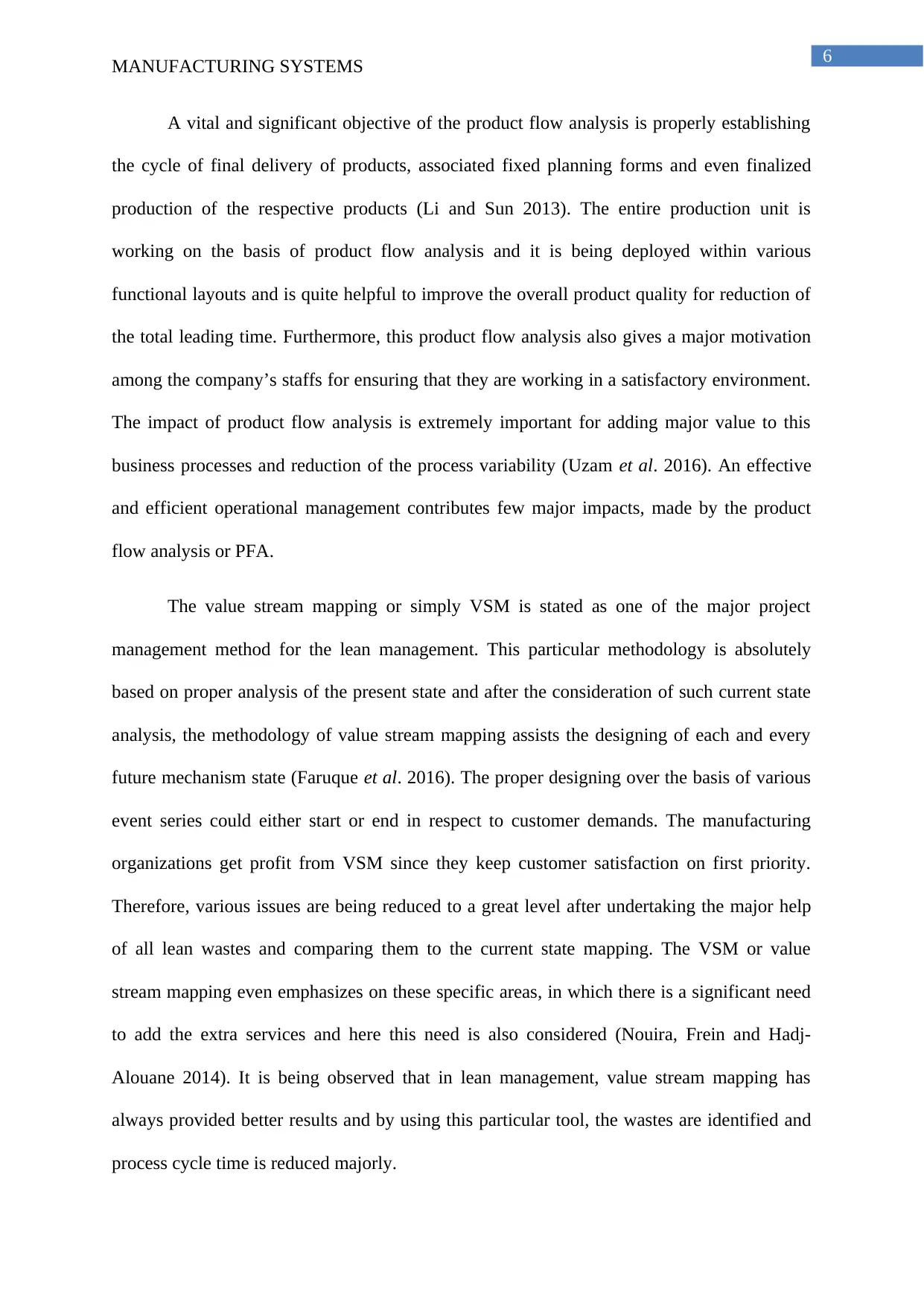
6
MANUFACTURING SYSTEMS
A vital and significant objective of the product flow analysis is properly establishing
the cycle of final delivery of products, associated fixed planning forms and even finalized
production of the respective products (Li and Sun 2013). The entire production unit is
working on the basis of product flow analysis and it is being deployed within various
functional layouts and is quite helpful to improve the overall product quality for reduction of
the total leading time. Furthermore, this product flow analysis also gives a major motivation
among the company’s staffs for ensuring that they are working in a satisfactory environment.
The impact of product flow analysis is extremely important for adding major value to this
business processes and reduction of the process variability (Uzam et al. 2016). An effective
and efficient operational management contributes few major impacts, made by the product
flow analysis or PFA.
The value stream mapping or simply VSM is stated as one of the major project
management method for the lean management. This particular methodology is absolutely
based on proper analysis of the present state and after the consideration of such current state
analysis, the methodology of value stream mapping assists the designing of each and every
future mechanism state (Faruque et al. 2016). The proper designing over the basis of various
event series could either start or end in respect to customer demands. The manufacturing
organizations get profit from VSM since they keep customer satisfaction on first priority.
Therefore, various issues are being reduced to a great level after undertaking the major help
of all lean wastes and comparing them to the current state mapping. The VSM or value
stream mapping even emphasizes on these specific areas, in which there is a significant need
to add the extra services and here this need is also considered (Nouira, Frein and Hadj-
Alouane 2014). It is being observed that in lean management, value stream mapping has
always provided better results and by using this particular tool, the wastes are identified and
process cycle time is reduced majorly.
MANUFACTURING SYSTEMS
A vital and significant objective of the product flow analysis is properly establishing
the cycle of final delivery of products, associated fixed planning forms and even finalized
production of the respective products (Li and Sun 2013). The entire production unit is
working on the basis of product flow analysis and it is being deployed within various
functional layouts and is quite helpful to improve the overall product quality for reduction of
the total leading time. Furthermore, this product flow analysis also gives a major motivation
among the company’s staffs for ensuring that they are working in a satisfactory environment.
The impact of product flow analysis is extremely important for adding major value to this
business processes and reduction of the process variability (Uzam et al. 2016). An effective
and efficient operational management contributes few major impacts, made by the product
flow analysis or PFA.
The value stream mapping or simply VSM is stated as one of the major project
management method for the lean management. This particular methodology is absolutely
based on proper analysis of the present state and after the consideration of such current state
analysis, the methodology of value stream mapping assists the designing of each and every
future mechanism state (Faruque et al. 2016). The proper designing over the basis of various
event series could either start or end in respect to customer demands. The manufacturing
organizations get profit from VSM since they keep customer satisfaction on first priority.
Therefore, various issues are being reduced to a great level after undertaking the major help
of all lean wastes and comparing them to the current state mapping. The VSM or value
stream mapping even emphasizes on these specific areas, in which there is a significant need
to add the extra services and here this need is also considered (Nouira, Frein and Hadj-
Alouane 2014). It is being observed that in lean management, value stream mapping has
always provided better results and by using this particular tool, the wastes are identified and
process cycle time is reduced majorly.
Paraphrase This Document
Need a fresh take? Get an instant paraphrase of this document with our AI Paraphraser
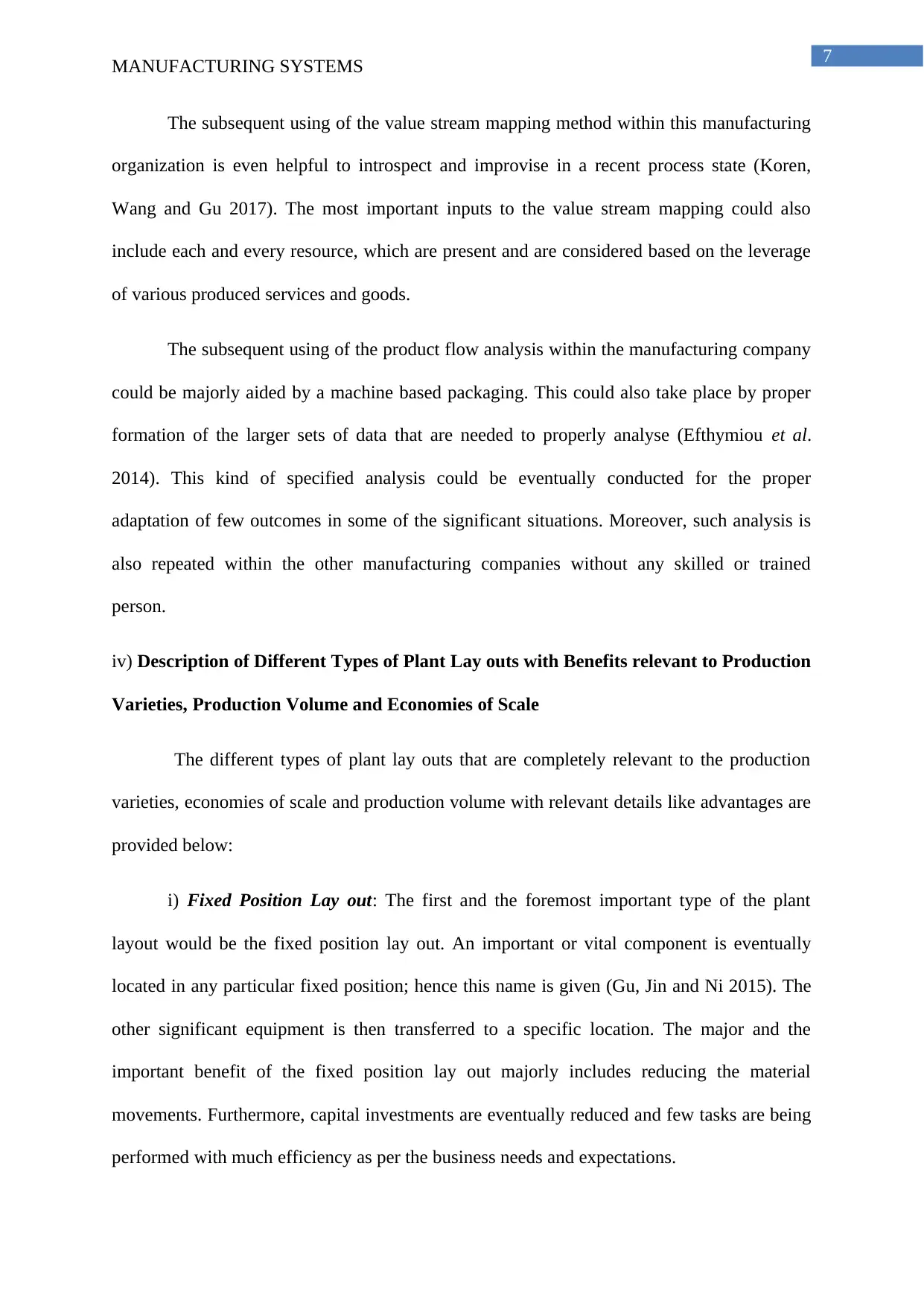
7
MANUFACTURING SYSTEMS
The subsequent using of the value stream mapping method within this manufacturing
organization is even helpful to introspect and improvise in a recent process state (Koren,
Wang and Gu 2017). The most important inputs to the value stream mapping could also
include each and every resource, which are present and are considered based on the leverage
of various produced services and goods.
The subsequent using of the product flow analysis within the manufacturing company
could be majorly aided by a machine based packaging. This could also take place by proper
formation of the larger sets of data that are needed to properly analyse (Efthymiou et al.
2014). This kind of specified analysis could be eventually conducted for the proper
adaptation of few outcomes in some of the significant situations. Moreover, such analysis is
also repeated within the other manufacturing companies without any skilled or trained
person.
iv) Description of Different Types of Plant Lay outs with Benefits relevant to Production
Varieties, Production Volume and Economies of Scale
The different types of plant lay outs that are completely relevant to the production
varieties, economies of scale and production volume with relevant details like advantages are
provided below:
i) Fixed Position Lay out: The first and the foremost important type of the plant
layout would be the fixed position lay out. An important or vital component is eventually
located in any particular fixed position; hence this name is given (Gu, Jin and Ni 2015). The
other significant equipment is then transferred to a specific location. The major and the
important benefit of the fixed position lay out majorly includes reducing the material
movements. Furthermore, capital investments are eventually reduced and few tasks are being
performed with much efficiency as per the business needs and expectations.
MANUFACTURING SYSTEMS
The subsequent using of the value stream mapping method within this manufacturing
organization is even helpful to introspect and improvise in a recent process state (Koren,
Wang and Gu 2017). The most important inputs to the value stream mapping could also
include each and every resource, which are present and are considered based on the leverage
of various produced services and goods.
The subsequent using of the product flow analysis within the manufacturing company
could be majorly aided by a machine based packaging. This could also take place by proper
formation of the larger sets of data that are needed to properly analyse (Efthymiou et al.
2014). This kind of specified analysis could be eventually conducted for the proper
adaptation of few outcomes in some of the significant situations. Moreover, such analysis is
also repeated within the other manufacturing companies without any skilled or trained
person.
iv) Description of Different Types of Plant Lay outs with Benefits relevant to Production
Varieties, Production Volume and Economies of Scale
The different types of plant lay outs that are completely relevant to the production
varieties, economies of scale and production volume with relevant details like advantages are
provided below:
i) Fixed Position Lay out: The first and the foremost important type of the plant
layout would be the fixed position lay out. An important or vital component is eventually
located in any particular fixed position; hence this name is given (Gu, Jin and Ni 2015). The
other significant equipment is then transferred to a specific location. The major and the
important benefit of the fixed position lay out majorly includes reducing the material
movements. Furthermore, capital investments are eventually reduced and few tasks are being
performed with much efficiency as per the business needs and expectations.
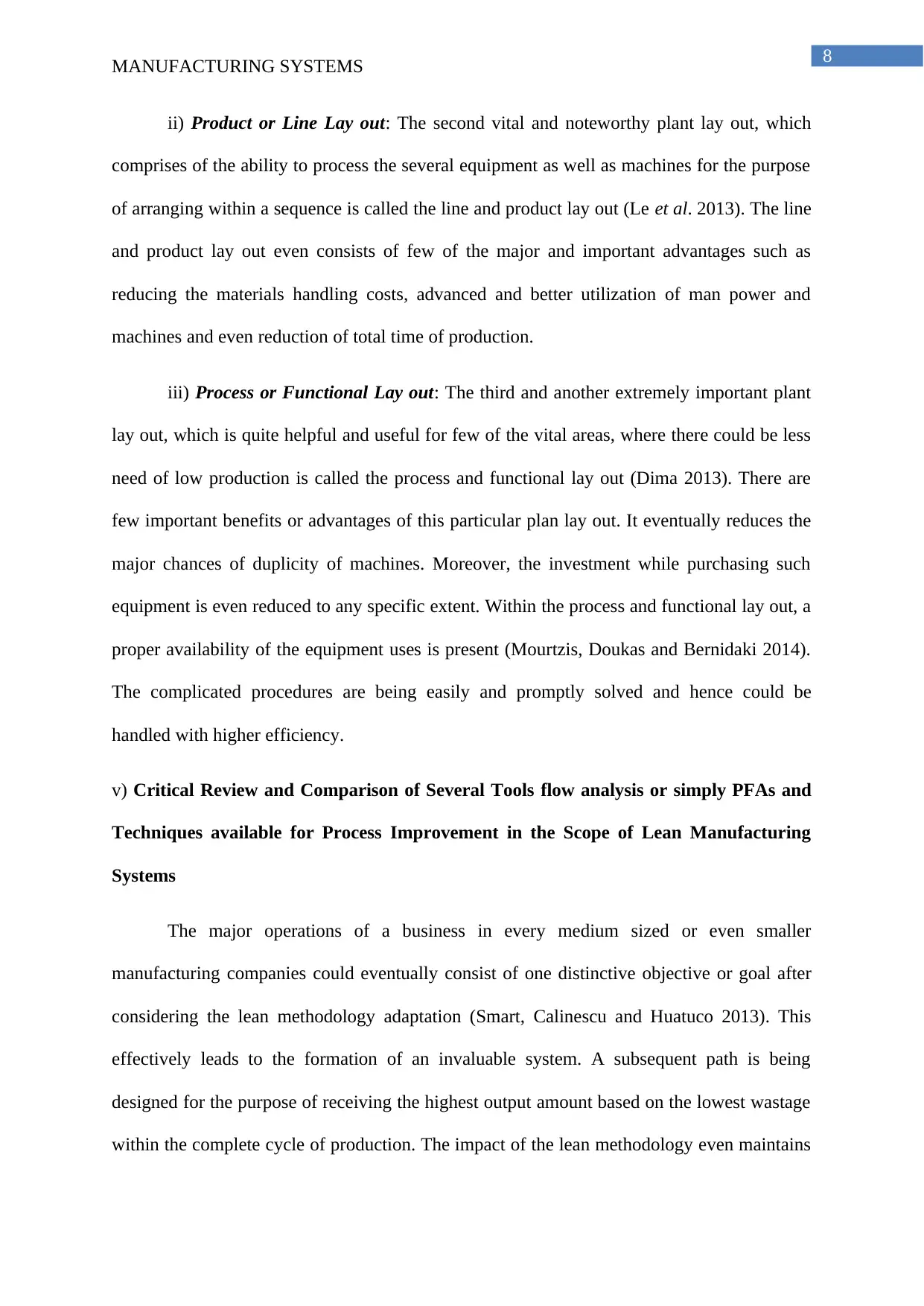
8
MANUFACTURING SYSTEMS
ii) Product or Line Lay out: The second vital and noteworthy plant lay out, which
comprises of the ability to process the several equipment as well as machines for the purpose
of arranging within a sequence is called the line and product lay out (Le et al. 2013). The line
and product lay out even consists of few of the major and important advantages such as
reducing the materials handling costs, advanced and better utilization of man power and
machines and even reduction of total time of production.
iii) Process or Functional Lay out: The third and another extremely important plant
lay out, which is quite helpful and useful for few of the vital areas, where there could be less
need of low production is called the process and functional lay out (Dima 2013). There are
few important benefits or advantages of this particular plan lay out. It eventually reduces the
major chances of duplicity of machines. Moreover, the investment while purchasing such
equipment is even reduced to any specific extent. Within the process and functional lay out, a
proper availability of the equipment uses is present (Mourtzis, Doukas and Bernidaki 2014).
The complicated procedures are being easily and promptly solved and hence could be
handled with higher efficiency.
v) Critical Review and Comparison of Several Tools flow analysis or simply PFAs and
Techniques available for Process Improvement in the Scope of Lean Manufacturing
Systems
The major operations of a business in every medium sized or even smaller
manufacturing companies could eventually consist of one distinctive objective or goal after
considering the lean methodology adaptation (Smart, Calinescu and Huatuco 2013). This
effectively leads to the formation of an invaluable system. A subsequent path is being
designed for the purpose of receiving the highest output amount based on the lowest wastage
within the complete cycle of production. The impact of the lean methodology even maintains
MANUFACTURING SYSTEMS
ii) Product or Line Lay out: The second vital and noteworthy plant lay out, which
comprises of the ability to process the several equipment as well as machines for the purpose
of arranging within a sequence is called the line and product lay out (Le et al. 2013). The line
and product lay out even consists of few of the major and important advantages such as
reducing the materials handling costs, advanced and better utilization of man power and
machines and even reduction of total time of production.
iii) Process or Functional Lay out: The third and another extremely important plant
lay out, which is quite helpful and useful for few of the vital areas, where there could be less
need of low production is called the process and functional lay out (Dima 2013). There are
few important benefits or advantages of this particular plan lay out. It eventually reduces the
major chances of duplicity of machines. Moreover, the investment while purchasing such
equipment is even reduced to any specific extent. Within the process and functional lay out, a
proper availability of the equipment uses is present (Mourtzis, Doukas and Bernidaki 2014).
The complicated procedures are being easily and promptly solved and hence could be
handled with higher efficiency.
v) Critical Review and Comparison of Several Tools flow analysis or simply PFAs and
Techniques available for Process Improvement in the Scope of Lean Manufacturing
Systems
The major operations of a business in every medium sized or even smaller
manufacturing companies could eventually consist of one distinctive objective or goal after
considering the lean methodology adaptation (Smart, Calinescu and Huatuco 2013). This
effectively leads to the formation of an invaluable system. A subsequent path is being
designed for the purpose of receiving the highest output amount based on the lowest wastage
within the complete cycle of production. The impact of the lean methodology even maintains
You're viewing a preview
Unlock full access by subscribing today!
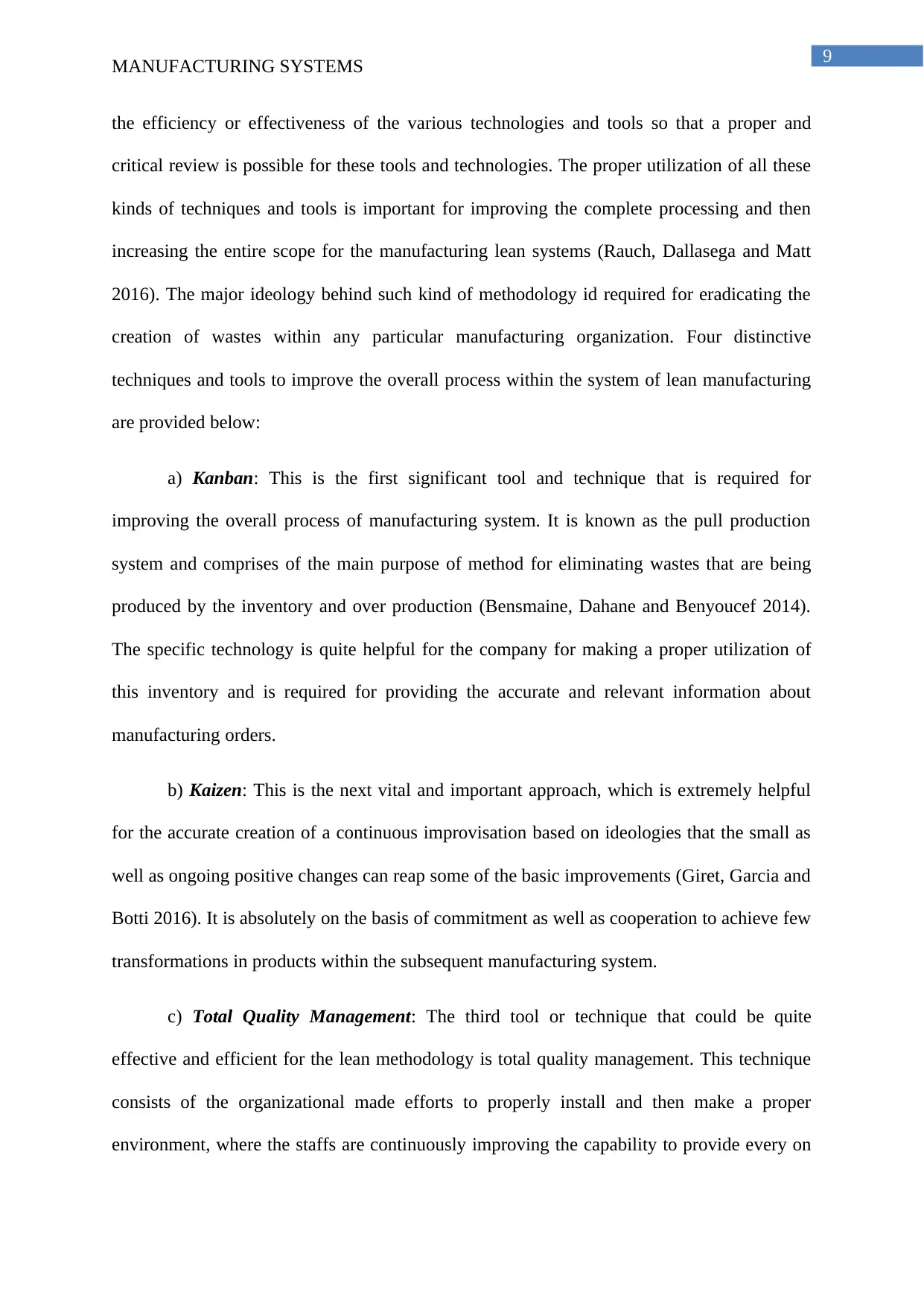
9
MANUFACTURING SYSTEMS
the efficiency or effectiveness of the various technologies and tools so that a proper and
critical review is possible for these tools and technologies. The proper utilization of all these
kinds of techniques and tools is important for improving the complete processing and then
increasing the entire scope for the manufacturing lean systems (Rauch, Dallasega and Matt
2016). The major ideology behind such kind of methodology id required for eradicating the
creation of wastes within any particular manufacturing organization. Four distinctive
techniques and tools to improve the overall process within the system of lean manufacturing
are provided below:
a) Kanban: This is the first significant tool and technique that is required for
improving the overall process of manufacturing system. It is known as the pull production
system and comprises of the main purpose of method for eliminating wastes that are being
produced by the inventory and over production (Bensmaine, Dahane and Benyoucef 2014).
The specific technology is quite helpful for the company for making a proper utilization of
this inventory and is required for providing the accurate and relevant information about
manufacturing orders.
b) Kaizen: This is the next vital and important approach, which is extremely helpful
for the accurate creation of a continuous improvisation based on ideologies that the small as
well as ongoing positive changes can reap some of the basic improvements (Giret, Garcia and
Botti 2016). It is absolutely on the basis of commitment as well as cooperation to achieve few
transformations in products within the subsequent manufacturing system.
c) Total Quality Management: The third tool or technique that could be quite
effective and efficient for the lean methodology is total quality management. This technique
consists of the organizational made efforts to properly install and then make a proper
environment, where the staffs are continuously improving the capability to provide every on
MANUFACTURING SYSTEMS
the efficiency or effectiveness of the various technologies and tools so that a proper and
critical review is possible for these tools and technologies. The proper utilization of all these
kinds of techniques and tools is important for improving the complete processing and then
increasing the entire scope for the manufacturing lean systems (Rauch, Dallasega and Matt
2016). The major ideology behind such kind of methodology id required for eradicating the
creation of wastes within any particular manufacturing organization. Four distinctive
techniques and tools to improve the overall process within the system of lean manufacturing
are provided below:
a) Kanban: This is the first significant tool and technique that is required for
improving the overall process of manufacturing system. It is known as the pull production
system and comprises of the main purpose of method for eliminating wastes that are being
produced by the inventory and over production (Bensmaine, Dahane and Benyoucef 2014).
The specific technology is quite helpful for the company for making a proper utilization of
this inventory and is required for providing the accurate and relevant information about
manufacturing orders.
b) Kaizen: This is the next vital and important approach, which is extremely helpful
for the accurate creation of a continuous improvisation based on ideologies that the small as
well as ongoing positive changes can reap some of the basic improvements (Giret, Garcia and
Botti 2016). It is absolutely on the basis of commitment as well as cooperation to achieve few
transformations in products within the subsequent manufacturing system.
c) Total Quality Management: The third tool or technique that could be quite
effective and efficient for the lean methodology is total quality management. This technique
consists of the organizational made efforts to properly install and then make a proper
environment, where the staffs are continuously improving the capability to provide every on
Paraphrase This Document
Need a fresh take? Get an instant paraphrase of this document with our AI Paraphraser

10
MANUFACTURING SYSTEMS
demand product or service (Novas and Henning 2014). This product and service that the
clients are searching are maintained properly with this particular technique.
d) Value Stream Mapping: VSM or value stream mapping is the fourth effective and
important technique of lean methodology. This particular methodology is absolutely based on
proper analysis of the present state and after the consideration of such current state analysis,
the methodology of value stream mapping assists the designing of each and every future
mechanism state (Chen and Li 2013). The proper designing over the basis of various event
series could either start or end in respect to customer demands. Hence, the organizations get
several advantages from this technique.
vi) Definition of Acronyms
a) CNC: The full form is Computer Numerical Control. This is a type of machine that
majorly involves the manufacturing procedures.
b) CAD: The full form is Computer Aided Design. It is a major process, in which
drafting as well as designing functioning are well performed.
c) BOM: The full form is Bill of Materials (Tibaut, Rebolj and Perc 2016). This is the
methodology for comprehensive inventories based on some raw materials, components, parts,
assemblies or sub assemblies.
d) CAM: The full form is Computer Aided Manufacturing. This is the technology that
uses machinery impacts or software utilization for facilitating manufacturing process.
e) CAPP: The full form is Computer Aided Process Planning. It is a specific use of
computer based technology for planning.
f) AGV: The full form is Automated Guided Vehicle, which is a portable robotic
system.
MANUFACTURING SYSTEMS
demand product or service (Novas and Henning 2014). This product and service that the
clients are searching are maintained properly with this particular technique.
d) Value Stream Mapping: VSM or value stream mapping is the fourth effective and
important technique of lean methodology. This particular methodology is absolutely based on
proper analysis of the present state and after the consideration of such current state analysis,
the methodology of value stream mapping assists the designing of each and every future
mechanism state (Chen and Li 2013). The proper designing over the basis of various event
series could either start or end in respect to customer demands. Hence, the organizations get
several advantages from this technique.
vi) Definition of Acronyms
a) CNC: The full form is Computer Numerical Control. This is a type of machine that
majorly involves the manufacturing procedures.
b) CAD: The full form is Computer Aided Design. It is a major process, in which
drafting as well as designing functioning are well performed.
c) BOM: The full form is Bill of Materials (Tibaut, Rebolj and Perc 2016). This is the
methodology for comprehensive inventories based on some raw materials, components, parts,
assemblies or sub assemblies.
d) CAM: The full form is Computer Aided Manufacturing. This is the technology that
uses machinery impacts or software utilization for facilitating manufacturing process.
e) CAPP: The full form is Computer Aided Process Planning. It is a specific use of
computer based technology for planning.
f) AGV: The full form is Automated Guided Vehicle, which is a portable robotic
system.
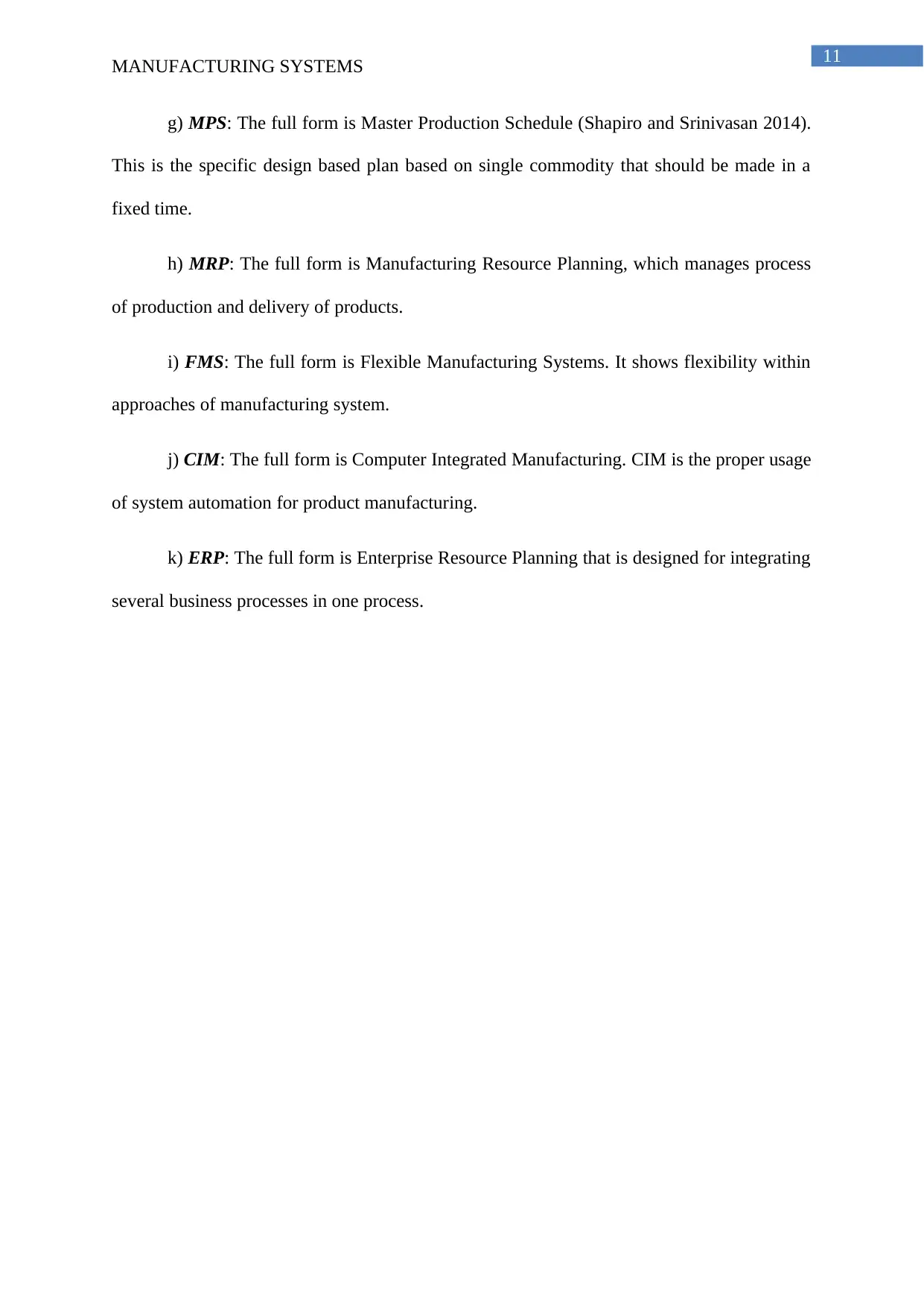
11
MANUFACTURING SYSTEMS
g) MPS: The full form is Master Production Schedule (Shapiro and Srinivasan 2014).
This is the specific design based plan based on single commodity that should be made in a
fixed time.
h) MRP: The full form is Manufacturing Resource Planning, which manages process
of production and delivery of products.
i) FMS: The full form is Flexible Manufacturing Systems. It shows flexibility within
approaches of manufacturing system.
j) CIM: The full form is Computer Integrated Manufacturing. CIM is the proper usage
of system automation for product manufacturing.
k) ERP: The full form is Enterprise Resource Planning that is designed for integrating
several business processes in one process.
MANUFACTURING SYSTEMS
g) MPS: The full form is Master Production Schedule (Shapiro and Srinivasan 2014).
This is the specific design based plan based on single commodity that should be made in a
fixed time.
h) MRP: The full form is Manufacturing Resource Planning, which manages process
of production and delivery of products.
i) FMS: The full form is Flexible Manufacturing Systems. It shows flexibility within
approaches of manufacturing system.
j) CIM: The full form is Computer Integrated Manufacturing. CIM is the proper usage
of system automation for product manufacturing.
k) ERP: The full form is Enterprise Resource Planning that is designed for integrating
several business processes in one process.
You're viewing a preview
Unlock full access by subscribing today!
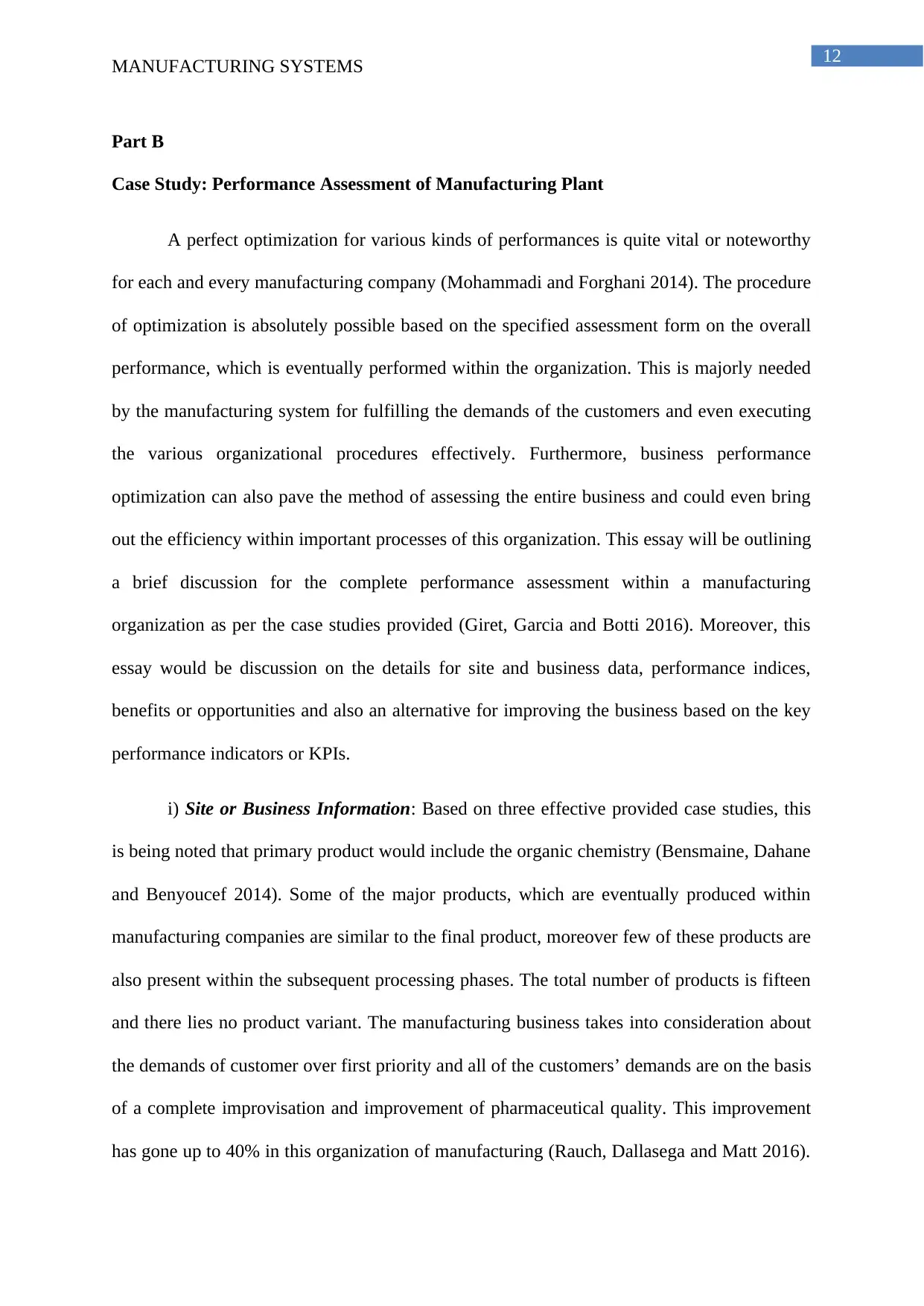
12
MANUFACTURING SYSTEMS
Part B
Case Study: Performance Assessment of Manufacturing Plant
A perfect optimization for various kinds of performances is quite vital or noteworthy
for each and every manufacturing company (Mohammadi and Forghani 2014). The procedure
of optimization is absolutely possible based on the specified assessment form on the overall
performance, which is eventually performed within the organization. This is majorly needed
by the manufacturing system for fulfilling the demands of the customers and even executing
the various organizational procedures effectively. Furthermore, business performance
optimization can also pave the method of assessing the entire business and could even bring
out the efficiency within important processes of this organization. This essay will be outlining
a brief discussion for the complete performance assessment within a manufacturing
organization as per the case studies provided (Giret, Garcia and Botti 2016). Moreover, this
essay would be discussion on the details for site and business data, performance indices,
benefits or opportunities and also an alternative for improving the business based on the key
performance indicators or KPIs.
i) Site or Business Information: Based on three effective provided case studies, this
is being noted that primary product would include the organic chemistry (Bensmaine, Dahane
and Benyoucef 2014). Some of the major products, which are eventually produced within
manufacturing companies are similar to the final product, moreover few of these products are
also present within the subsequent processing phases. The total number of products is fifteen
and there lies no product variant. The manufacturing business takes into consideration about
the demands of customer over first priority and all of the customers’ demands are on the basis
of a complete improvisation and improvement of pharmaceutical quality. This improvement
has gone up to 40% in this organization of manufacturing (Rauch, Dallasega and Matt 2016).
MANUFACTURING SYSTEMS
Part B
Case Study: Performance Assessment of Manufacturing Plant
A perfect optimization for various kinds of performances is quite vital or noteworthy
for each and every manufacturing company (Mohammadi and Forghani 2014). The procedure
of optimization is absolutely possible based on the specified assessment form on the overall
performance, which is eventually performed within the organization. This is majorly needed
by the manufacturing system for fulfilling the demands of the customers and even executing
the various organizational procedures effectively. Furthermore, business performance
optimization can also pave the method of assessing the entire business and could even bring
out the efficiency within important processes of this organization. This essay will be outlining
a brief discussion for the complete performance assessment within a manufacturing
organization as per the case studies provided (Giret, Garcia and Botti 2016). Moreover, this
essay would be discussion on the details for site and business data, performance indices,
benefits or opportunities and also an alternative for improving the business based on the key
performance indicators or KPIs.
i) Site or Business Information: Based on three effective provided case studies, this
is being noted that primary product would include the organic chemistry (Bensmaine, Dahane
and Benyoucef 2014). Some of the major products, which are eventually produced within
manufacturing companies are similar to the final product, moreover few of these products are
also present within the subsequent processing phases. The total number of products is fifteen
and there lies no product variant. The manufacturing business takes into consideration about
the demands of customer over first priority and all of the customers’ demands are on the basis
of a complete improvisation and improvement of pharmaceutical quality. This improvement
has gone up to 40% in this organization of manufacturing (Rauch, Dallasega and Matt 2016).
Paraphrase This Document
Need a fresh take? Get an instant paraphrase of this document with our AI Paraphraser
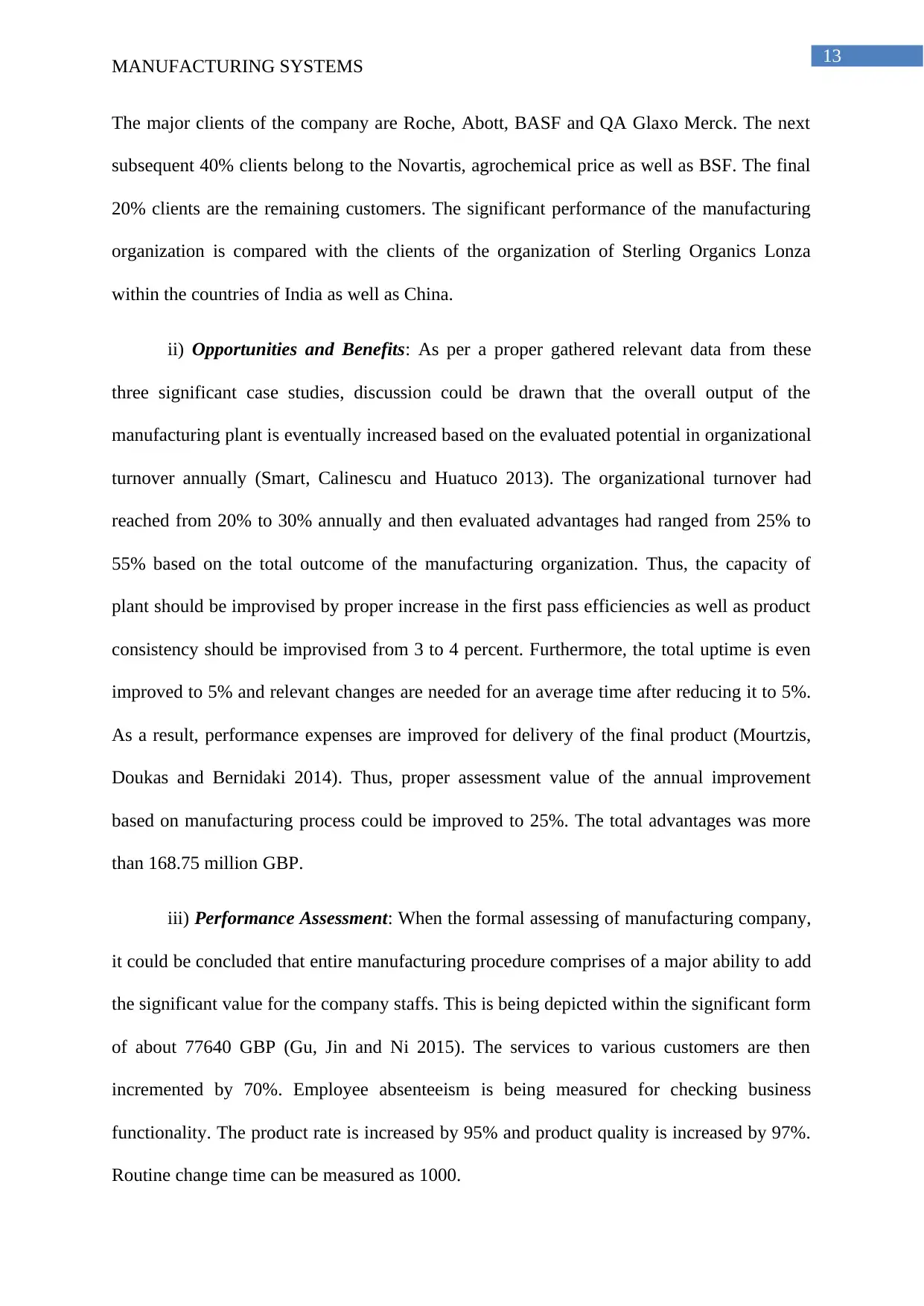
13
MANUFACTURING SYSTEMS
The major clients of the company are Roche, Abott, BASF and QA Glaxo Merck. The next
subsequent 40% clients belong to the Novartis, agrochemical price as well as BSF. The final
20% clients are the remaining customers. The significant performance of the manufacturing
organization is compared with the clients of the organization of Sterling Organics Lonza
within the countries of India as well as China.
ii) Opportunities and Benefits: As per a proper gathered relevant data from these
three significant case studies, discussion could be drawn that the overall output of the
manufacturing plant is eventually increased based on the evaluated potential in organizational
turnover annually (Smart, Calinescu and Huatuco 2013). The organizational turnover had
reached from 20% to 30% annually and then evaluated advantages had ranged from 25% to
55% based on the total outcome of the manufacturing organization. Thus, the capacity of
plant should be improvised by proper increase in the first pass efficiencies as well as product
consistency should be improvised from 3 to 4 percent. Furthermore, the total uptime is even
improved to 5% and relevant changes are needed for an average time after reducing it to 5%.
As a result, performance expenses are improved for delivery of the final product (Mourtzis,
Doukas and Bernidaki 2014). Thus, proper assessment value of the annual improvement
based on manufacturing process could be improved to 25%. The total advantages was more
than 168.75 million GBP.
iii) Performance Assessment: When the formal assessing of manufacturing company,
it could be concluded that entire manufacturing procedure comprises of a major ability to add
the significant value for the company staffs. This is being depicted within the significant form
of about 77640 GBP (Gu, Jin and Ni 2015). The services to various customers are then
incremented by 70%. Employee absenteeism is being measured for checking business
functionality. The product rate is increased by 95% and product quality is increased by 97%.
Routine change time can be measured as 1000.
MANUFACTURING SYSTEMS
The major clients of the company are Roche, Abott, BASF and QA Glaxo Merck. The next
subsequent 40% clients belong to the Novartis, agrochemical price as well as BSF. The final
20% clients are the remaining customers. The significant performance of the manufacturing
organization is compared with the clients of the organization of Sterling Organics Lonza
within the countries of India as well as China.
ii) Opportunities and Benefits: As per a proper gathered relevant data from these
three significant case studies, discussion could be drawn that the overall output of the
manufacturing plant is eventually increased based on the evaluated potential in organizational
turnover annually (Smart, Calinescu and Huatuco 2013). The organizational turnover had
reached from 20% to 30% annually and then evaluated advantages had ranged from 25% to
55% based on the total outcome of the manufacturing organization. Thus, the capacity of
plant should be improvised by proper increase in the first pass efficiencies as well as product
consistency should be improvised from 3 to 4 percent. Furthermore, the total uptime is even
improved to 5% and relevant changes are needed for an average time after reducing it to 5%.
As a result, performance expenses are improved for delivery of the final product (Mourtzis,
Doukas and Bernidaki 2014). Thus, proper assessment value of the annual improvement
based on manufacturing process could be improved to 25%. The total advantages was more
than 168.75 million GBP.
iii) Performance Assessment: When the formal assessing of manufacturing company,
it could be concluded that entire manufacturing procedure comprises of a major ability to add
the significant value for the company staffs. This is being depicted within the significant form
of about 77640 GBP (Gu, Jin and Ni 2015). The services to various customers are then
incremented by 70%. Employee absenteeism is being measured for checking business
functionality. The product rate is increased by 95% and product quality is increased by 97%.
Routine change time can be measured as 1000.
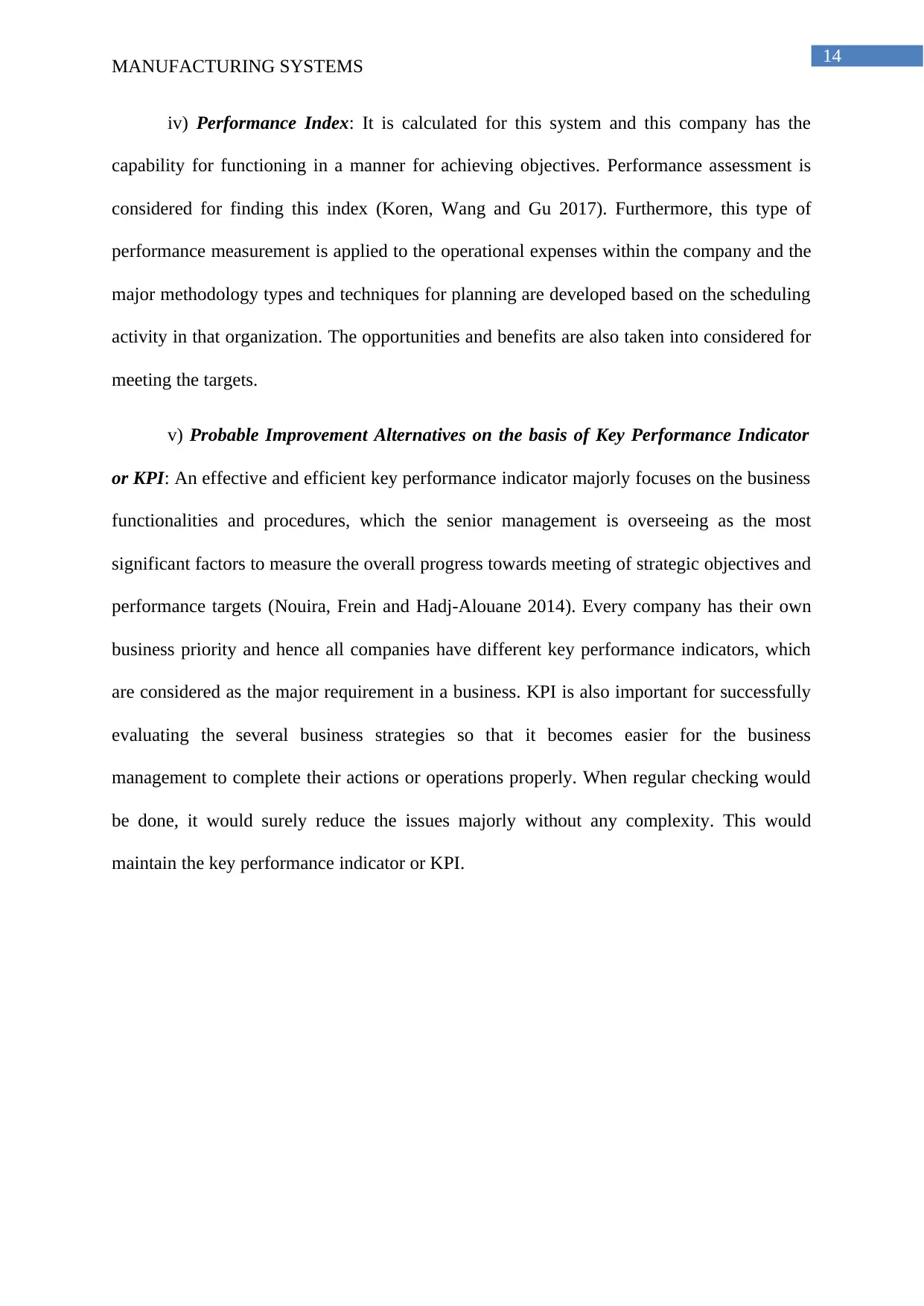
14
MANUFACTURING SYSTEMS
iv) Performance Index: It is calculated for this system and this company has the
capability for functioning in a manner for achieving objectives. Performance assessment is
considered for finding this index (Koren, Wang and Gu 2017). Furthermore, this type of
performance measurement is applied to the operational expenses within the company and the
major methodology types and techniques for planning are developed based on the scheduling
activity in that organization. The opportunities and benefits are also taken into considered for
meeting the targets.
v) Probable Improvement Alternatives on the basis of Key Performance Indicator
or KPI: An effective and efficient key performance indicator majorly focuses on the business
functionalities and procedures, which the senior management is overseeing as the most
significant factors to measure the overall progress towards meeting of strategic objectives and
performance targets (Nouira, Frein and Hadj-Alouane 2014). Every company has their own
business priority and hence all companies have different key performance indicators, which
are considered as the major requirement in a business. KPI is also important for successfully
evaluating the several business strategies so that it becomes easier for the business
management to complete their actions or operations properly. When regular checking would
be done, it would surely reduce the issues majorly without any complexity. This would
maintain the key performance indicator or KPI.
MANUFACTURING SYSTEMS
iv) Performance Index: It is calculated for this system and this company has the
capability for functioning in a manner for achieving objectives. Performance assessment is
considered for finding this index (Koren, Wang and Gu 2017). Furthermore, this type of
performance measurement is applied to the operational expenses within the company and the
major methodology types and techniques for planning are developed based on the scheduling
activity in that organization. The opportunities and benefits are also taken into considered for
meeting the targets.
v) Probable Improvement Alternatives on the basis of Key Performance Indicator
or KPI: An effective and efficient key performance indicator majorly focuses on the business
functionalities and procedures, which the senior management is overseeing as the most
significant factors to measure the overall progress towards meeting of strategic objectives and
performance targets (Nouira, Frein and Hadj-Alouane 2014). Every company has their own
business priority and hence all companies have different key performance indicators, which
are considered as the major requirement in a business. KPI is also important for successfully
evaluating the several business strategies so that it becomes easier for the business
management to complete their actions or operations properly. When regular checking would
be done, it would surely reduce the issues majorly without any complexity. This would
maintain the key performance indicator or KPI.
You're viewing a preview
Unlock full access by subscribing today!
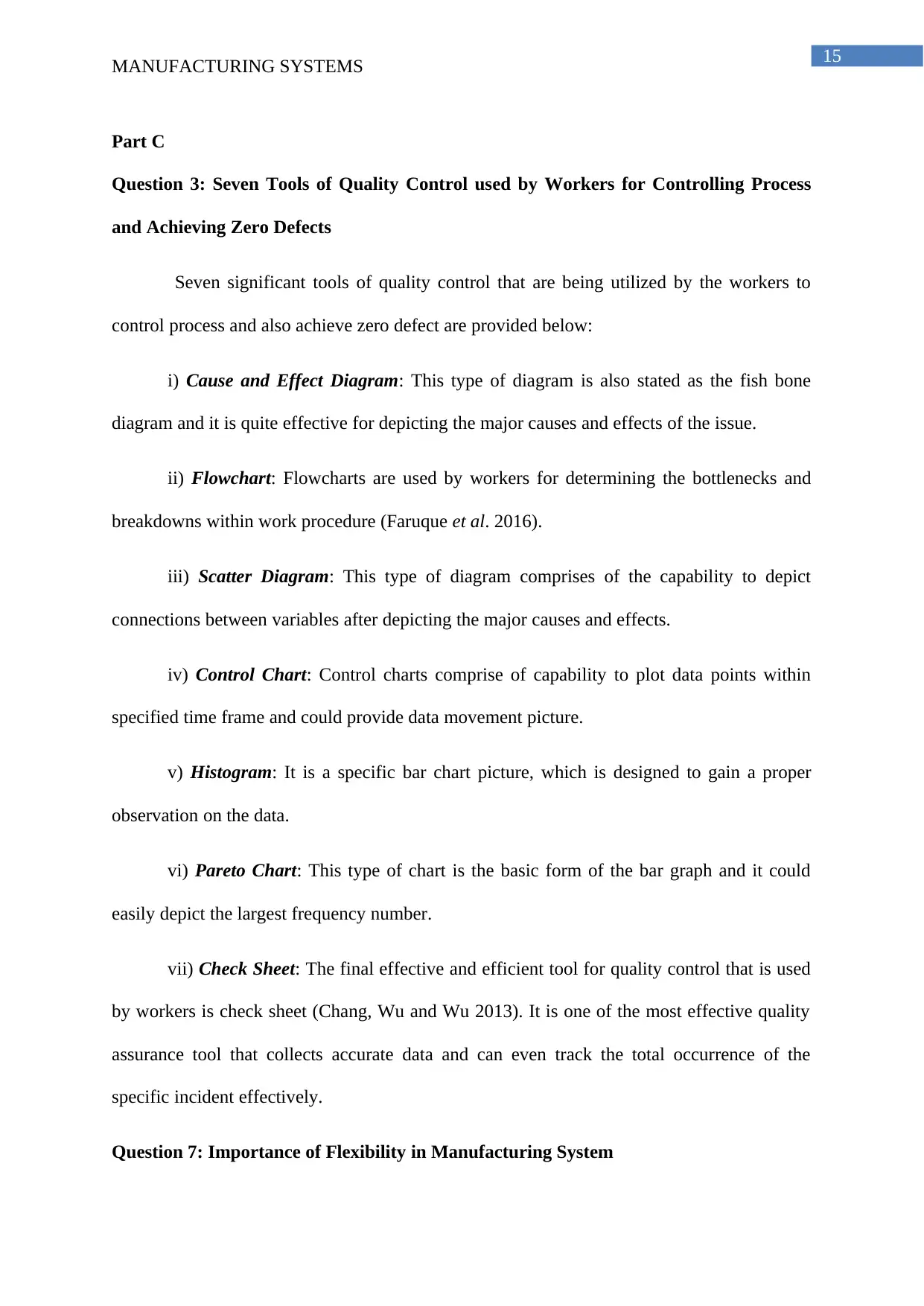
15
MANUFACTURING SYSTEMS
Part C
Question 3: Seven Tools of Quality Control used by Workers for Controlling Process
and Achieving Zero Defects
Seven significant tools of quality control that are being utilized by the workers to
control process and also achieve zero defect are provided below:
i) Cause and Effect Diagram: This type of diagram is also stated as the fish bone
diagram and it is quite effective for depicting the major causes and effects of the issue.
ii) Flowchart: Flowcharts are used by workers for determining the bottlenecks and
breakdowns within work procedure (Faruque et al. 2016).
iii) Scatter Diagram: This type of diagram comprises of the capability to depict
connections between variables after depicting the major causes and effects.
iv) Control Chart: Control charts comprise of capability to plot data points within
specified time frame and could provide data movement picture.
v) Histogram: It is a specific bar chart picture, which is designed to gain a proper
observation on the data.
vi) Pareto Chart: This type of chart is the basic form of the bar graph and it could
easily depict the largest frequency number.
vii) Check Sheet: The final effective and efficient tool for quality control that is used
by workers is check sheet (Chang, Wu and Wu 2013). It is one of the most effective quality
assurance tool that collects accurate data and can even track the total occurrence of the
specific incident effectively.
Question 7: Importance of Flexibility in Manufacturing System
MANUFACTURING SYSTEMS
Part C
Question 3: Seven Tools of Quality Control used by Workers for Controlling Process
and Achieving Zero Defects
Seven significant tools of quality control that are being utilized by the workers to
control process and also achieve zero defect are provided below:
i) Cause and Effect Diagram: This type of diagram is also stated as the fish bone
diagram and it is quite effective for depicting the major causes and effects of the issue.
ii) Flowchart: Flowcharts are used by workers for determining the bottlenecks and
breakdowns within work procedure (Faruque et al. 2016).
iii) Scatter Diagram: This type of diagram comprises of the capability to depict
connections between variables after depicting the major causes and effects.
iv) Control Chart: Control charts comprise of capability to plot data points within
specified time frame and could provide data movement picture.
v) Histogram: It is a specific bar chart picture, which is designed to gain a proper
observation on the data.
vi) Pareto Chart: This type of chart is the basic form of the bar graph and it could
easily depict the largest frequency number.
vii) Check Sheet: The final effective and efficient tool for quality control that is used
by workers is check sheet (Chang, Wu and Wu 2013). It is one of the most effective quality
assurance tool that collects accurate data and can even track the total occurrence of the
specific incident effectively.
Question 7: Importance of Flexibility in Manufacturing System
Paraphrase This Document
Need a fresh take? Get an instant paraphrase of this document with our AI Paraphraser
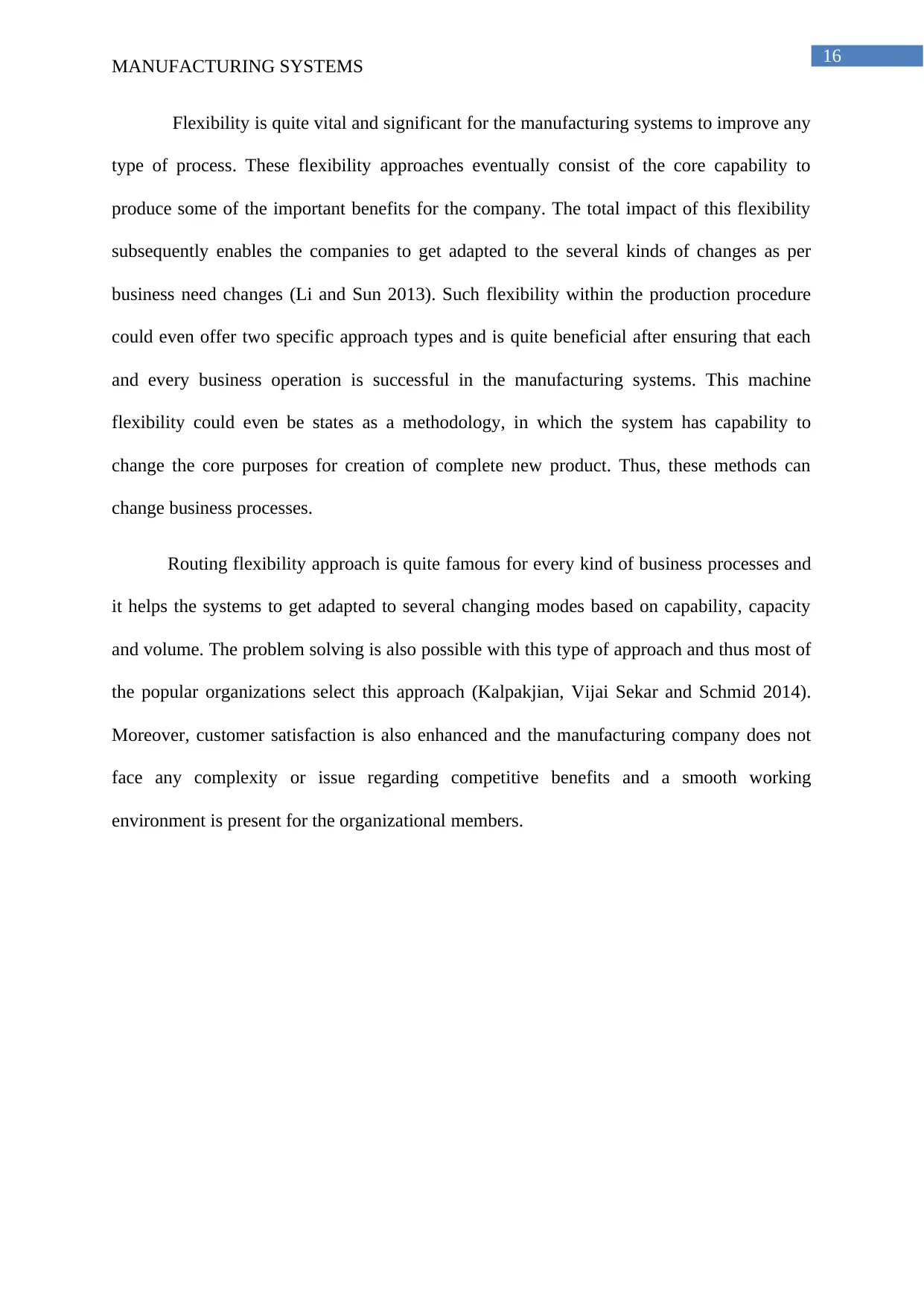
16
MANUFACTURING SYSTEMS
Flexibility is quite vital and significant for the manufacturing systems to improve any
type of process. These flexibility approaches eventually consist of the core capability to
produce some of the important benefits for the company. The total impact of this flexibility
subsequently enables the companies to get adapted to the several kinds of changes as per
business need changes (Li and Sun 2013). Such flexibility within the production procedure
could even offer two specific approach types and is quite beneficial after ensuring that each
and every business operation is successful in the manufacturing systems. This machine
flexibility could even be states as a methodology, in which the system has capability to
change the core purposes for creation of complete new product. Thus, these methods can
change business processes.
Routing flexibility approach is quite famous for every kind of business processes and
it helps the systems to get adapted to several changing modes based on capability, capacity
and volume. The problem solving is also possible with this type of approach and thus most of
the popular organizations select this approach (Kalpakjian, Vijai Sekar and Schmid 2014).
Moreover, customer satisfaction is also enhanced and the manufacturing company does not
face any complexity or issue regarding competitive benefits and a smooth working
environment is present for the organizational members.
MANUFACTURING SYSTEMS
Flexibility is quite vital and significant for the manufacturing systems to improve any
type of process. These flexibility approaches eventually consist of the core capability to
produce some of the important benefits for the company. The total impact of this flexibility
subsequently enables the companies to get adapted to the several kinds of changes as per
business need changes (Li and Sun 2013). Such flexibility within the production procedure
could even offer two specific approach types and is quite beneficial after ensuring that each
and every business operation is successful in the manufacturing systems. This machine
flexibility could even be states as a methodology, in which the system has capability to
change the core purposes for creation of complete new product. Thus, these methods can
change business processes.
Routing flexibility approach is quite famous for every kind of business processes and
it helps the systems to get adapted to several changing modes based on capability, capacity
and volume. The problem solving is also possible with this type of approach and thus most of
the popular organizations select this approach (Kalpakjian, Vijai Sekar and Schmid 2014).
Moreover, customer satisfaction is also enhanced and the manufacturing company does not
face any complexity or issue regarding competitive benefits and a smooth working
environment is present for the organizational members.
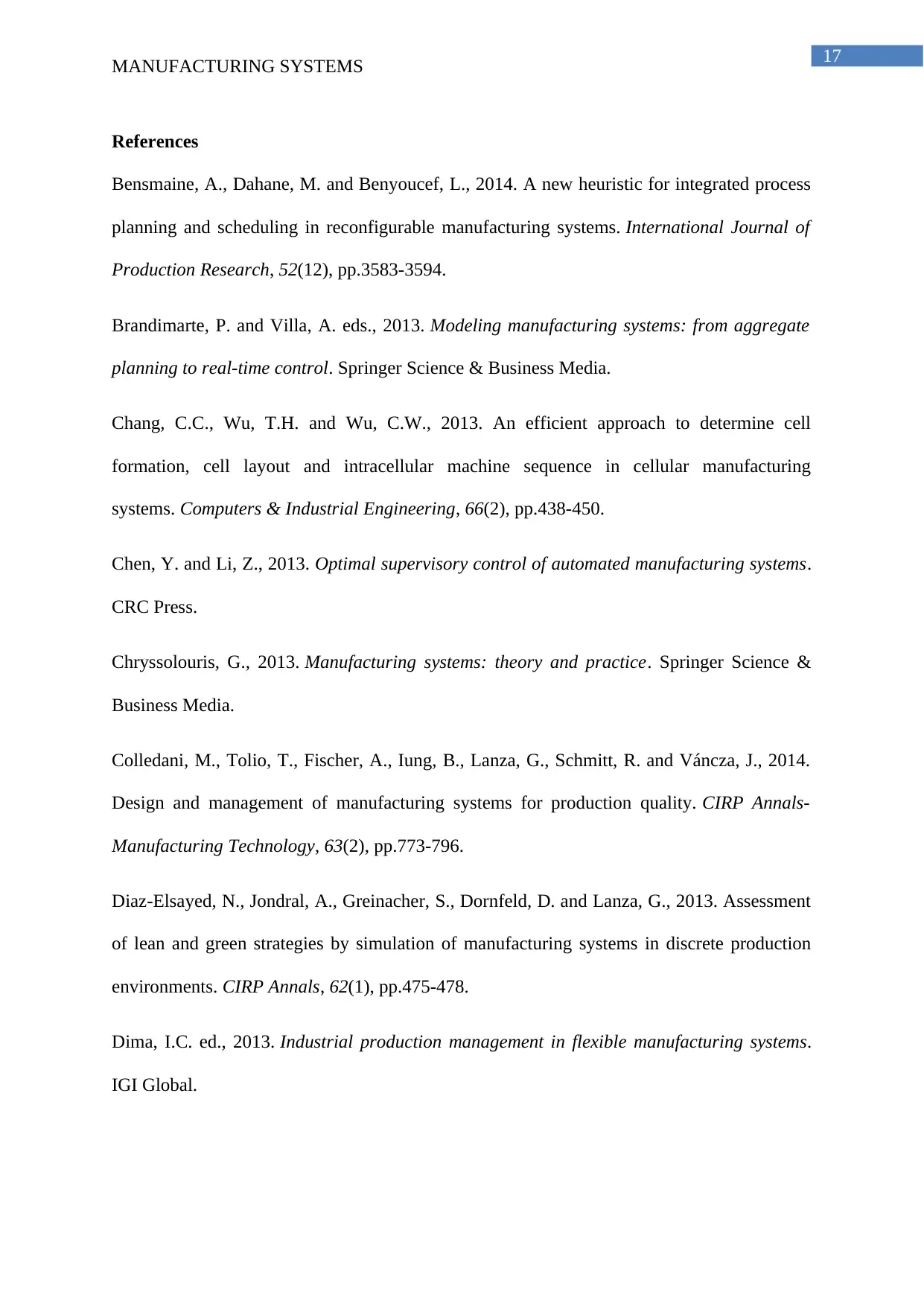
17
MANUFACTURING SYSTEMS
References
Bensmaine, A., Dahane, M. and Benyoucef, L., 2014. A new heuristic for integrated process
planning and scheduling in reconfigurable manufacturing systems. International Journal of
Production Research, 52(12), pp.3583-3594.
Brandimarte, P. and Villa, A. eds., 2013. Modeling manufacturing systems: from aggregate
planning to real-time control. Springer Science & Business Media.
Chang, C.C., Wu, T.H. and Wu, C.W., 2013. An efficient approach to determine cell
formation, cell layout and intracellular machine sequence in cellular manufacturing
systems. Computers & Industrial Engineering, 66(2), pp.438-450.
Chen, Y. and Li, Z., 2013. Optimal supervisory control of automated manufacturing systems.
CRC Press.
Chryssolouris, G., 2013. Manufacturing systems: theory and practice. Springer Science &
Business Media.
Colledani, M., Tolio, T., Fischer, A., Iung, B., Lanza, G., Schmitt, R. and Váncza, J., 2014.
Design and management of manufacturing systems for production quality. CIRP Annals-
Manufacturing Technology, 63(2), pp.773-796.
Diaz-Elsayed, N., Jondral, A., Greinacher, S., Dornfeld, D. and Lanza, G., 2013. Assessment
of lean and green strategies by simulation of manufacturing systems in discrete production
environments. CIRP Annals, 62(1), pp.475-478.
Dima, I.C. ed., 2013. Industrial production management in flexible manufacturing systems.
IGI Global.
MANUFACTURING SYSTEMS
References
Bensmaine, A., Dahane, M. and Benyoucef, L., 2014. A new heuristic for integrated process
planning and scheduling in reconfigurable manufacturing systems. International Journal of
Production Research, 52(12), pp.3583-3594.
Brandimarte, P. and Villa, A. eds., 2013. Modeling manufacturing systems: from aggregate
planning to real-time control. Springer Science & Business Media.
Chang, C.C., Wu, T.H. and Wu, C.W., 2013. An efficient approach to determine cell
formation, cell layout and intracellular machine sequence in cellular manufacturing
systems. Computers & Industrial Engineering, 66(2), pp.438-450.
Chen, Y. and Li, Z., 2013. Optimal supervisory control of automated manufacturing systems.
CRC Press.
Chryssolouris, G., 2013. Manufacturing systems: theory and practice. Springer Science &
Business Media.
Colledani, M., Tolio, T., Fischer, A., Iung, B., Lanza, G., Schmitt, R. and Váncza, J., 2014.
Design and management of manufacturing systems for production quality. CIRP Annals-
Manufacturing Technology, 63(2), pp.773-796.
Diaz-Elsayed, N., Jondral, A., Greinacher, S., Dornfeld, D. and Lanza, G., 2013. Assessment
of lean and green strategies by simulation of manufacturing systems in discrete production
environments. CIRP Annals, 62(1), pp.475-478.
Dima, I.C. ed., 2013. Industrial production management in flexible manufacturing systems.
IGI Global.
You're viewing a preview
Unlock full access by subscribing today!
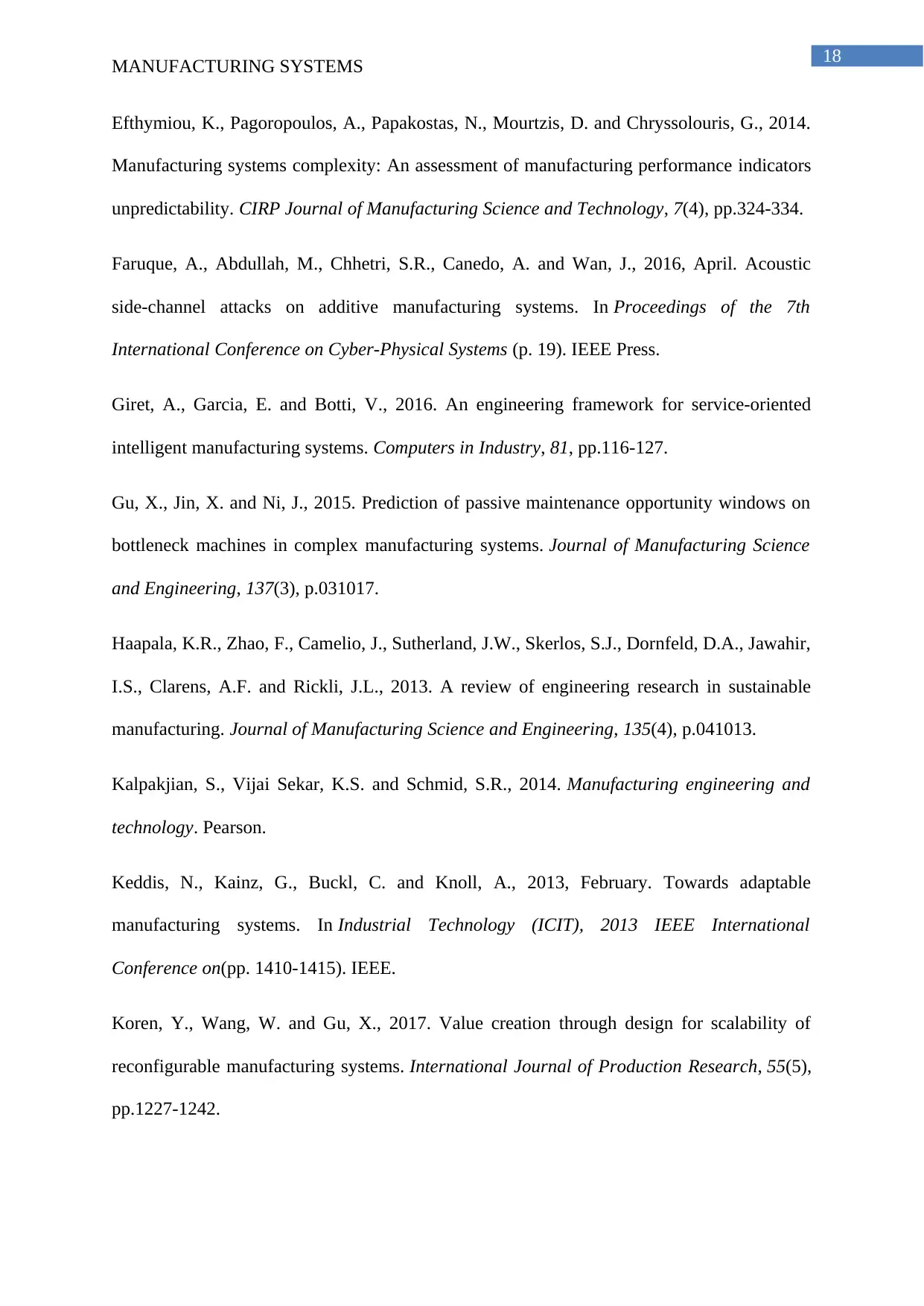
18
MANUFACTURING SYSTEMS
Efthymiou, K., Pagoropoulos, A., Papakostas, N., Mourtzis, D. and Chryssolouris, G., 2014.
Manufacturing systems complexity: An assessment of manufacturing performance indicators
unpredictability. CIRP Journal of Manufacturing Science and Technology, 7(4), pp.324-334.
Faruque, A., Abdullah, M., Chhetri, S.R., Canedo, A. and Wan, J., 2016, April. Acoustic
side-channel attacks on additive manufacturing systems. In Proceedings of the 7th
International Conference on Cyber-Physical Systems (p. 19). IEEE Press.
Giret, A., Garcia, E. and Botti, V., 2016. An engineering framework for service-oriented
intelligent manufacturing systems. Computers in Industry, 81, pp.116-127.
Gu, X., Jin, X. and Ni, J., 2015. Prediction of passive maintenance opportunity windows on
bottleneck machines in complex manufacturing systems. Journal of Manufacturing Science
and Engineering, 137(3), p.031017.
Haapala, K.R., Zhao, F., Camelio, J., Sutherland, J.W., Skerlos, S.J., Dornfeld, D.A., Jawahir,
I.S., Clarens, A.F. and Rickli, J.L., 2013. A review of engineering research in sustainable
manufacturing. Journal of Manufacturing Science and Engineering, 135(4), p.041013.
Kalpakjian, S., Vijai Sekar, K.S. and Schmid, S.R., 2014. Manufacturing engineering and
technology. Pearson.
Keddis, N., Kainz, G., Buckl, C. and Knoll, A., 2013, February. Towards adaptable
manufacturing systems. In Industrial Technology (ICIT), 2013 IEEE International
Conference on(pp. 1410-1415). IEEE.
Koren, Y., Wang, W. and Gu, X., 2017. Value creation through design for scalability of
reconfigurable manufacturing systems. International Journal of Production Research, 55(5),
pp.1227-1242.
MANUFACTURING SYSTEMS
Efthymiou, K., Pagoropoulos, A., Papakostas, N., Mourtzis, D. and Chryssolouris, G., 2014.
Manufacturing systems complexity: An assessment of manufacturing performance indicators
unpredictability. CIRP Journal of Manufacturing Science and Technology, 7(4), pp.324-334.
Faruque, A., Abdullah, M., Chhetri, S.R., Canedo, A. and Wan, J., 2016, April. Acoustic
side-channel attacks on additive manufacturing systems. In Proceedings of the 7th
International Conference on Cyber-Physical Systems (p. 19). IEEE Press.
Giret, A., Garcia, E. and Botti, V., 2016. An engineering framework for service-oriented
intelligent manufacturing systems. Computers in Industry, 81, pp.116-127.
Gu, X., Jin, X. and Ni, J., 2015. Prediction of passive maintenance opportunity windows on
bottleneck machines in complex manufacturing systems. Journal of Manufacturing Science
and Engineering, 137(3), p.031017.
Haapala, K.R., Zhao, F., Camelio, J., Sutherland, J.W., Skerlos, S.J., Dornfeld, D.A., Jawahir,
I.S., Clarens, A.F. and Rickli, J.L., 2013. A review of engineering research in sustainable
manufacturing. Journal of Manufacturing Science and Engineering, 135(4), p.041013.
Kalpakjian, S., Vijai Sekar, K.S. and Schmid, S.R., 2014. Manufacturing engineering and
technology. Pearson.
Keddis, N., Kainz, G., Buckl, C. and Knoll, A., 2013, February. Towards adaptable
manufacturing systems. In Industrial Technology (ICIT), 2013 IEEE International
Conference on(pp. 1410-1415). IEEE.
Koren, Y., Wang, W. and Gu, X., 2017. Value creation through design for scalability of
reconfigurable manufacturing systems. International Journal of Production Research, 55(5),
pp.1227-1242.
Paraphrase This Document
Need a fresh take? Get an instant paraphrase of this document with our AI Paraphraser
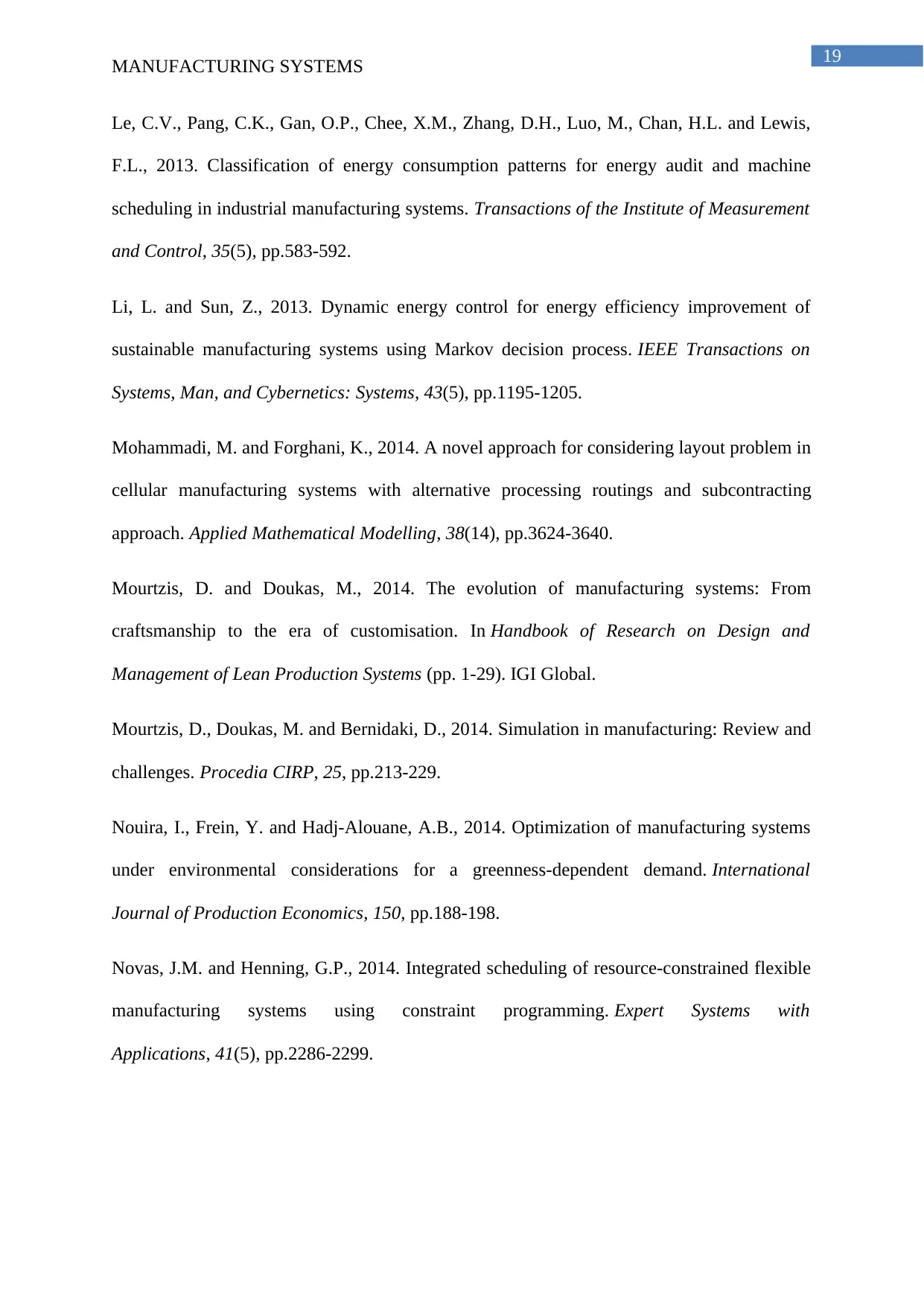
19
MANUFACTURING SYSTEMS
Le, C.V., Pang, C.K., Gan, O.P., Chee, X.M., Zhang, D.H., Luo, M., Chan, H.L. and Lewis,
F.L., 2013. Classification of energy consumption patterns for energy audit and machine
scheduling in industrial manufacturing systems. Transactions of the Institute of Measurement
and Control, 35(5), pp.583-592.
Li, L. and Sun, Z., 2013. Dynamic energy control for energy efficiency improvement of
sustainable manufacturing systems using Markov decision process. IEEE Transactions on
Systems, Man, and Cybernetics: Systems, 43(5), pp.1195-1205.
Mohammadi, M. and Forghani, K., 2014. A novel approach for considering layout problem in
cellular manufacturing systems with alternative processing routings and subcontracting
approach. Applied Mathematical Modelling, 38(14), pp.3624-3640.
Mourtzis, D. and Doukas, M., 2014. The evolution of manufacturing systems: From
craftsmanship to the era of customisation. In Handbook of Research on Design and
Management of Lean Production Systems (pp. 1-29). IGI Global.
Mourtzis, D., Doukas, M. and Bernidaki, D., 2014. Simulation in manufacturing: Review and
challenges. Procedia CIRP, 25, pp.213-229.
Nouira, I., Frein, Y. and Hadj-Alouane, A.B., 2014. Optimization of manufacturing systems
under environmental considerations for a greenness-dependent demand. International
Journal of Production Economics, 150, pp.188-198.
Novas, J.M. and Henning, G.P., 2014. Integrated scheduling of resource-constrained flexible
manufacturing systems using constraint programming. Expert Systems with
Applications, 41(5), pp.2286-2299.
MANUFACTURING SYSTEMS
Le, C.V., Pang, C.K., Gan, O.P., Chee, X.M., Zhang, D.H., Luo, M., Chan, H.L. and Lewis,
F.L., 2013. Classification of energy consumption patterns for energy audit and machine
scheduling in industrial manufacturing systems. Transactions of the Institute of Measurement
and Control, 35(5), pp.583-592.
Li, L. and Sun, Z., 2013. Dynamic energy control for energy efficiency improvement of
sustainable manufacturing systems using Markov decision process. IEEE Transactions on
Systems, Man, and Cybernetics: Systems, 43(5), pp.1195-1205.
Mohammadi, M. and Forghani, K., 2014. A novel approach for considering layout problem in
cellular manufacturing systems with alternative processing routings and subcontracting
approach. Applied Mathematical Modelling, 38(14), pp.3624-3640.
Mourtzis, D. and Doukas, M., 2014. The evolution of manufacturing systems: From
craftsmanship to the era of customisation. In Handbook of Research on Design and
Management of Lean Production Systems (pp. 1-29). IGI Global.
Mourtzis, D., Doukas, M. and Bernidaki, D., 2014. Simulation in manufacturing: Review and
challenges. Procedia CIRP, 25, pp.213-229.
Nouira, I., Frein, Y. and Hadj-Alouane, A.B., 2014. Optimization of manufacturing systems
under environmental considerations for a greenness-dependent demand. International
Journal of Production Economics, 150, pp.188-198.
Novas, J.M. and Henning, G.P., 2014. Integrated scheduling of resource-constrained flexible
manufacturing systems using constraint programming. Expert Systems with
Applications, 41(5), pp.2286-2299.
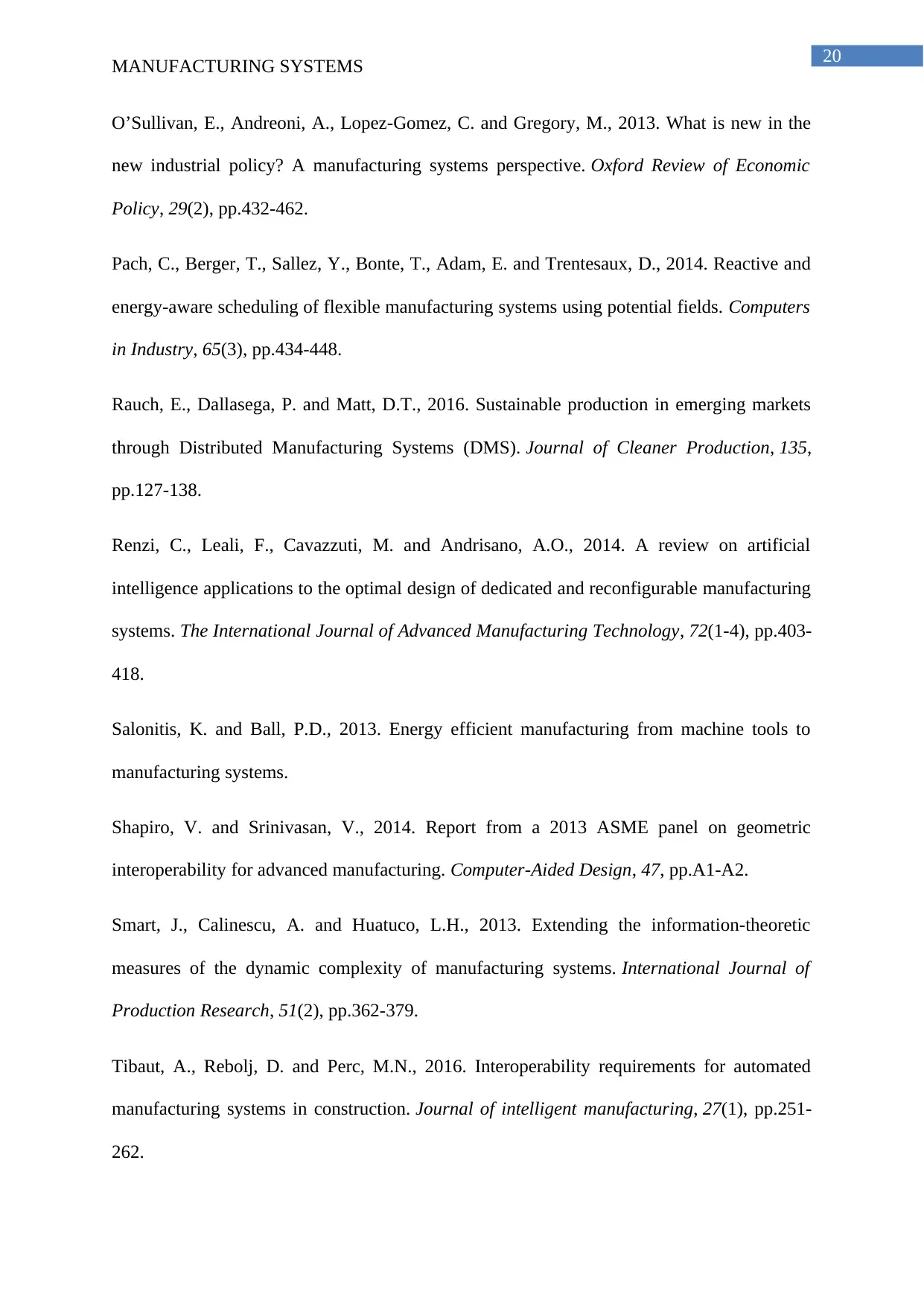
20
MANUFACTURING SYSTEMS
O’Sullivan, E., Andreoni, A., Lopez-Gomez, C. and Gregory, M., 2013. What is new in the
new industrial policy? A manufacturing systems perspective. Oxford Review of Economic
Policy, 29(2), pp.432-462.
Pach, C., Berger, T., Sallez, Y., Bonte, T., Adam, E. and Trentesaux, D., 2014. Reactive and
energy-aware scheduling of flexible manufacturing systems using potential fields. Computers
in Industry, 65(3), pp.434-448.
Rauch, E., Dallasega, P. and Matt, D.T., 2016. Sustainable production in emerging markets
through Distributed Manufacturing Systems (DMS). Journal of Cleaner Production, 135,
pp.127-138.
Renzi, C., Leali, F., Cavazzuti, M. and Andrisano, A.O., 2014. A review on artificial
intelligence applications to the optimal design of dedicated and reconfigurable manufacturing
systems. The International Journal of Advanced Manufacturing Technology, 72(1-4), pp.403-
418.
Salonitis, K. and Ball, P.D., 2013. Energy efficient manufacturing from machine tools to
manufacturing systems.
Shapiro, V. and Srinivasan, V., 2014. Report from a 2013 ASME panel on geometric
interoperability for advanced manufacturing. Computer-Aided Design, 47, pp.A1-A2.
Smart, J., Calinescu, A. and Huatuco, L.H., 2013. Extending the information-theoretic
measures of the dynamic complexity of manufacturing systems. International Journal of
Production Research, 51(2), pp.362-379.
Tibaut, A., Rebolj, D. and Perc, M.N., 2016. Interoperability requirements for automated
manufacturing systems in construction. Journal of intelligent manufacturing, 27(1), pp.251-
262.
MANUFACTURING SYSTEMS
O’Sullivan, E., Andreoni, A., Lopez-Gomez, C. and Gregory, M., 2013. What is new in the
new industrial policy? A manufacturing systems perspective. Oxford Review of Economic
Policy, 29(2), pp.432-462.
Pach, C., Berger, T., Sallez, Y., Bonte, T., Adam, E. and Trentesaux, D., 2014. Reactive and
energy-aware scheduling of flexible manufacturing systems using potential fields. Computers
in Industry, 65(3), pp.434-448.
Rauch, E., Dallasega, P. and Matt, D.T., 2016. Sustainable production in emerging markets
through Distributed Manufacturing Systems (DMS). Journal of Cleaner Production, 135,
pp.127-138.
Renzi, C., Leali, F., Cavazzuti, M. and Andrisano, A.O., 2014. A review on artificial
intelligence applications to the optimal design of dedicated and reconfigurable manufacturing
systems. The International Journal of Advanced Manufacturing Technology, 72(1-4), pp.403-
418.
Salonitis, K. and Ball, P.D., 2013. Energy efficient manufacturing from machine tools to
manufacturing systems.
Shapiro, V. and Srinivasan, V., 2014. Report from a 2013 ASME panel on geometric
interoperability for advanced manufacturing. Computer-Aided Design, 47, pp.A1-A2.
Smart, J., Calinescu, A. and Huatuco, L.H., 2013. Extending the information-theoretic
measures of the dynamic complexity of manufacturing systems. International Journal of
Production Research, 51(2), pp.362-379.
Tibaut, A., Rebolj, D. and Perc, M.N., 2016. Interoperability requirements for automated
manufacturing systems in construction. Journal of intelligent manufacturing, 27(1), pp.251-
262.
You're viewing a preview
Unlock full access by subscribing today!
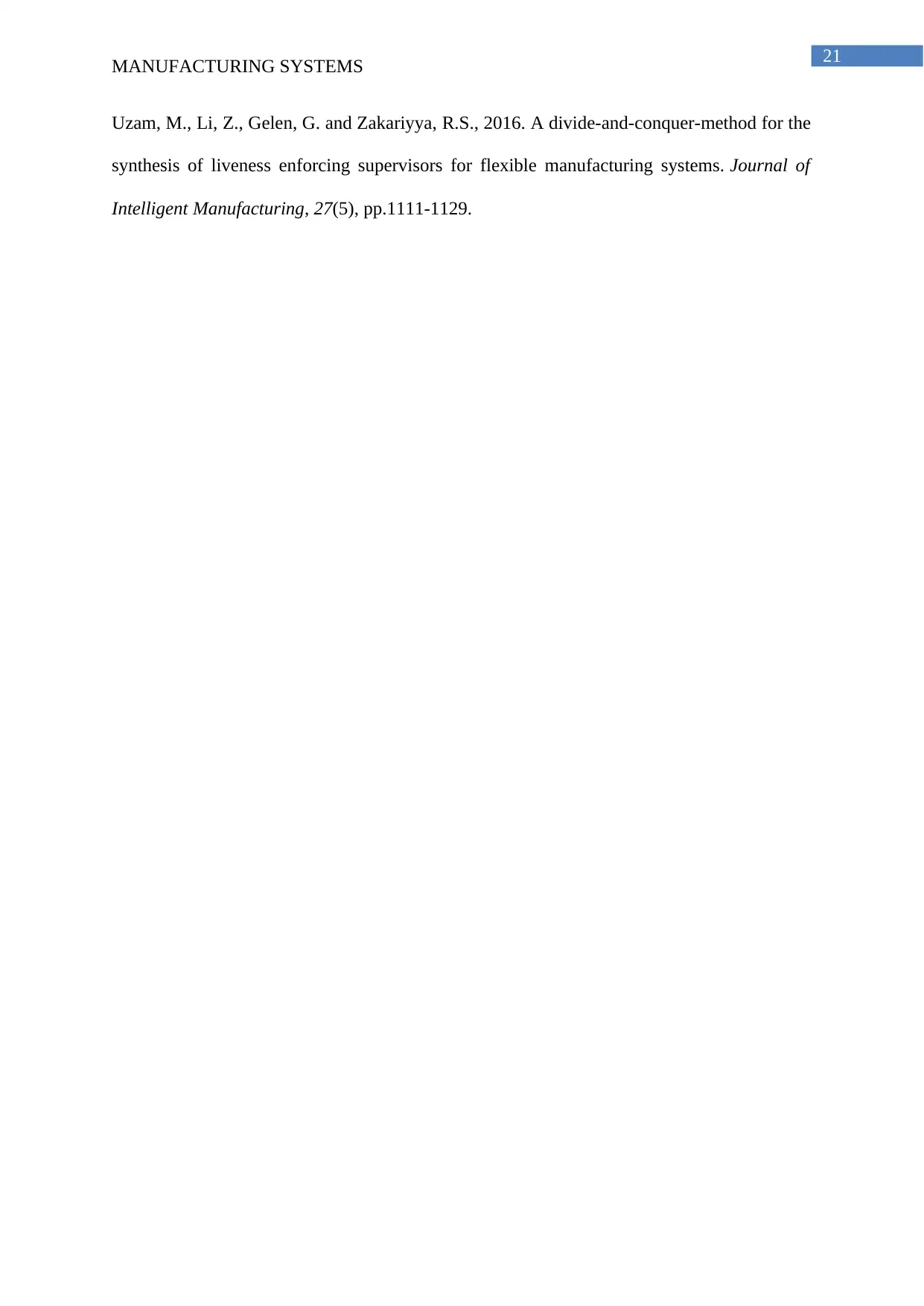
21
MANUFACTURING SYSTEMS
Uzam, M., Li, Z., Gelen, G. and Zakariyya, R.S., 2016. A divide-and-conquer-method for the
synthesis of liveness enforcing supervisors for flexible manufacturing systems. Journal of
Intelligent Manufacturing, 27(5), pp.1111-1129.
MANUFACTURING SYSTEMS
Uzam, M., Li, Z., Gelen, G. and Zakariyya, R.S., 2016. A divide-and-conquer-method for the
synthesis of liveness enforcing supervisors for flexible manufacturing systems. Journal of
Intelligent Manufacturing, 27(5), pp.1111-1129.
1 out of 22
Related Documents
Your All-in-One AI-Powered Toolkit for Academic Success.
+13062052269
info@desklib.com
Available 24*7 on WhatsApp / Email
![[object Object]](/_next/static/media/star-bottom.7253800d.svg)
Unlock your academic potential
© 2024 | Zucol Services PVT LTD | All rights reserved.




